

Is Time Travel Possible?
We all travel in time! We travel one year in time between birthdays, for example. And we are all traveling in time at approximately the same speed: 1 second per second.
We typically experience time at one second per second. Credit: NASA/JPL-Caltech
NASA's space telescopes also give us a way to look back in time. Telescopes help us see stars and galaxies that are very far away . It takes a long time for the light from faraway galaxies to reach us. So, when we look into the sky with a telescope, we are seeing what those stars and galaxies looked like a very long time ago.
However, when we think of the phrase "time travel," we are usually thinking of traveling faster than 1 second per second. That kind of time travel sounds like something you'd only see in movies or science fiction books. Could it be real? Science says yes!

This image from the Hubble Space Telescope shows galaxies that are very far away as they existed a very long time ago. Credit: NASA, ESA and R. Thompson (Univ. Arizona)
How do we know that time travel is possible?
More than 100 years ago, a famous scientist named Albert Einstein came up with an idea about how time works. He called it relativity. This theory says that time and space are linked together. Einstein also said our universe has a speed limit: nothing can travel faster than the speed of light (186,000 miles per second).
Einstein's theory of relativity says that space and time are linked together. Credit: NASA/JPL-Caltech
What does this mean for time travel? Well, according to this theory, the faster you travel, the slower you experience time. Scientists have done some experiments to show that this is true.
For example, there was an experiment that used two clocks set to the exact same time. One clock stayed on Earth, while the other flew in an airplane (going in the same direction Earth rotates).
After the airplane flew around the world, scientists compared the two clocks. The clock on the fast-moving airplane was slightly behind the clock on the ground. So, the clock on the airplane was traveling slightly slower in time than 1 second per second.
Credit: NASA/JPL-Caltech
Can we use time travel in everyday life?
We can't use a time machine to travel hundreds of years into the past or future. That kind of time travel only happens in books and movies. But the math of time travel does affect the things we use every day.
For example, we use GPS satellites to help us figure out how to get to new places. (Check out our video about how GPS satellites work .) NASA scientists also use a high-accuracy version of GPS to keep track of where satellites are in space. But did you know that GPS relies on time-travel calculations to help you get around town?
GPS satellites orbit around Earth very quickly at about 8,700 miles (14,000 kilometers) per hour. This slows down GPS satellite clocks by a small fraction of a second (similar to the airplane example above).

GPS satellites orbit around Earth at about 8,700 miles (14,000 kilometers) per hour. Credit: GPS.gov
However, the satellites are also orbiting Earth about 12,550 miles (20,200 km) above the surface. This actually speeds up GPS satellite clocks by a slighter larger fraction of a second.
Here's how: Einstein's theory also says that gravity curves space and time, causing the passage of time to slow down. High up where the satellites orbit, Earth's gravity is much weaker. This causes the clocks on GPS satellites to run faster than clocks on the ground.
The combined result is that the clocks on GPS satellites experience time at a rate slightly faster than 1 second per second. Luckily, scientists can use math to correct these differences in time.

If scientists didn't correct the GPS clocks, there would be big problems. GPS satellites wouldn't be able to correctly calculate their position or yours. The errors would add up to a few miles each day, which is a big deal. GPS maps might think your home is nowhere near where it actually is!
In Summary:
Yes, time travel is indeed a real thing. But it's not quite what you've probably seen in the movies. Under certain conditions, it is possible to experience time passing at a different rate than 1 second per second. And there are important reasons why we need to understand this real-world form of time travel.
If you liked this, you may like:
- Skip to main content
- Keyboard shortcuts for audio player

- LISTEN & FOLLOW
- Apple Podcasts
- Google Podcasts
- Amazon Music
- Amazon Alexa
Your support helps make our show possible and unlocks access to our sponsor-free feed.
Paradox-Free Time Travel Is Theoretically Possible, Researchers Say

Matthew S. Schwartz

A dog dressed as Marty McFly from Back to the Future attends the Tompkins Square Halloween Dog Parade in 2015. New research says time travel might be possible without the problems McFly encountered. Timothy A. Clary/AFP via Getty Images hide caption
A dog dressed as Marty McFly from Back to the Future attends the Tompkins Square Halloween Dog Parade in 2015. New research says time travel might be possible without the problems McFly encountered.
"The past is obdurate," Stephen King wrote in his book about a man who goes back in time to prevent the Kennedy assassination. "It doesn't want to be changed."
Turns out, King might have been on to something.
Countless science fiction tales have explored the paradox of what would happen if you went back in time and did something in the past that endangered the future. Perhaps one of the most famous pop culture examples is in Back to the Future , when Marty McFly goes back in time and accidentally stops his parents from meeting, putting his own existence in jeopardy.
But maybe McFly wasn't in much danger after all. According a new paper from researchers at the University of Queensland, even if time travel were possible, the paradox couldn't actually exist.
Researchers ran the numbers and determined that even if you made a change in the past, the timeline would essentially self-correct, ensuring that whatever happened to send you back in time would still happen.
"Say you traveled in time in an attempt to stop COVID-19's patient zero from being exposed to the virus," University of Queensland scientist Fabio Costa told the university's news service .
"However, if you stopped that individual from becoming infected, that would eliminate the motivation for you to go back and stop the pandemic in the first place," said Costa, who co-authored the paper with honors undergraduate student Germain Tobar.
"This is a paradox — an inconsistency that often leads people to think that time travel cannot occur in our universe."
A variation is known as the "grandfather paradox" — in which a time traveler kills their own grandfather, in the process preventing the time traveler's birth.
The logical paradox has given researchers a headache, in part because according to Einstein's theory of general relativity, "closed timelike curves" are possible, theoretically allowing an observer to travel back in time and interact with their past self — potentially endangering their own existence.
But these researchers say that such a paradox wouldn't necessarily exist, because events would adjust themselves.
Take the coronavirus patient zero example. "You might try and stop patient zero from becoming infected, but in doing so, you would catch the virus and become patient zero, or someone else would," Tobar told the university's news service.
In other words, a time traveler could make changes, but the original outcome would still find a way to happen — maybe not the same way it happened in the first timeline but close enough so that the time traveler would still exist and would still be motivated to go back in time.
"No matter what you did, the salient events would just recalibrate around you," Tobar said.
The paper, "Reversible dynamics with closed time-like curves and freedom of choice," was published last week in the peer-reviewed journal Classical and Quantum Gravity . The findings seem consistent with another time travel study published this summer in the peer-reviewed journal Physical Review Letters. That study found that changes made in the past won't drastically alter the future.
Bestselling science fiction author Blake Crouch, who has written extensively about time travel, said the new study seems to support what certain time travel tropes have posited all along.
"The universe is deterministic and attempts to alter Past Event X are destined to be the forces which bring Past Event X into being," Crouch told NPR via email. "So the future can affect the past. Or maybe time is just an illusion. But I guess it's cool that the math checks out."
- time travel
- grandfather paradox
Time travel: Is it possible?
Science says time travel is possible, but probably not in the way you're thinking.

Albert Einstein's theory
- General relativity and GPS
- Wormhole travel
- Alternate theories
Science fiction
Is time travel possible? Short answer: Yes, and you're doing it right now — hurtling into the future at the impressive rate of one second per second.
You're pretty much always moving through time at the same speed, whether you're watching paint dry or wishing you had more hours to visit with a friend from out of town.
But this isn't the kind of time travel that's captivated countless science fiction writers, or spurred a genre so extensive that Wikipedia lists over 400 titles in the category "Movies about Time Travel." In franchises like " Doctor Who ," " Star Trek ," and "Back to the Future" characters climb into some wild vehicle to blast into the past or spin into the future. Once the characters have traveled through time, they grapple with what happens if you change the past or present based on information from the future (which is where time travel stories intersect with the idea of parallel universes or alternate timelines).
Related: The best sci-fi time machines ever
Although many people are fascinated by the idea of changing the past or seeing the future before it's due, no person has ever demonstrated the kind of back-and-forth time travel seen in science fiction or proposed a method of sending a person through significant periods of time that wouldn't destroy them on the way. And, as physicist Stephen Hawking pointed out in his book " Black Holes and Baby Universes" (Bantam, 1994), "The best evidence we have that time travel is not possible, and never will be, is that we have not been invaded by hordes of tourists from the future."
Science does support some amount of time-bending, though. For example, physicist Albert Einstein 's theory of special relativity proposes that time is an illusion that moves relative to an observer. An observer traveling near the speed of light will experience time, with all its aftereffects (boredom, aging, etc.) much more slowly than an observer at rest. That's why astronaut Scott Kelly aged ever so slightly less over the course of a year in orbit than his twin brother who stayed here on Earth.
Related: Controversially, physicist argues that time is real
There are other scientific theories about time travel, including some weird physics that arise around wormholes , black holes and string theory . For the most part, though, time travel remains the domain of an ever-growing array of science fiction books, movies, television shows, comics, video games and more.

Einstein developed his theory of special relativity in 1905. Along with his later expansion, the theory of general relativity , it has become one of the foundational tenets of modern physics. Special relativity describes the relationship between space and time for objects moving at constant speeds in a straight line.
The short version of the theory is deceptively simple. First, all things are measured in relation to something else — that is to say, there is no "absolute" frame of reference. Second, the speed of light is constant. It stays the same no matter what, and no matter where it's measured from. And third, nothing can go faster than the speed of light.
From those simple tenets unfolds actual, real-life time travel. An observer traveling at high velocity will experience time at a slower rate than an observer who isn't speeding through space.
While we don't accelerate humans to near-light-speed, we do send them swinging around the planet at 17,500 mph (28,160 km/h) aboard the International Space Station . Astronaut Scott Kelly was born after his twin brother, and fellow astronaut, Mark Kelly . Scott Kelly spent 520 days in orbit, while Mark logged 54 days in space. The difference in the speed at which they experienced time over the course of their lifetimes has actually widened the age gap between the two men.
"So, where[as] I used to be just 6 minutes older, now I am 6 minutes and 5 milliseconds older," Mark Kelly said in a panel discussion on July 12, 2020, Space.com previously reported . "Now I've got that over his head."
General relativity and GPS time travel

The difference that low earth orbit makes in an astronaut's life span may be negligible — better suited for jokes among siblings than actual life extension or visiting the distant future — but the dilation in time between people on Earth and GPS satellites flying through space does make a difference.
Read more: Can we stop time?
The Global Positioning System , or GPS, helps us know exactly where we are by communicating with a network of a few dozen satellites positioned in a high Earth orbit. The satellites circle the planet from 12,500 miles (20,100 kilometers) away, moving at 8,700 mph (14,000 km/h).
According to special relativity, the faster an object moves relative to another object, the slower that first object experiences time. For GPS satellites with atomic clocks, this effect cuts 7 microseconds, or 7 millionths of a second, off each day, according to the American Physical Society publication Physics Central .
Read more: Could Star Trek's faster-than-light warp drive actually work?
Then, according to general relativity, clocks closer to the center of a large gravitational mass like Earth tick more slowly than those farther away. So, because the GPS satellites are much farther from the center of Earth compared to clocks on the surface, Physics Central added, that adds another 45 microseconds onto the GPS satellite clocks each day. Combined with the negative 7 microseconds from the special relativity calculation, the net result is an added 38 microseconds.
This means that in order to maintain the accuracy needed to pinpoint your car or phone — or, since the system is run by the U.S. Department of Defense, a military drone — engineers must account for an extra 38 microseconds in each satellite's day. The atomic clocks onboard don’t tick over to the next day until they have run 38 microseconds longer than comparable clocks on Earth.
Given those numbers, it would take more than seven years for the atomic clock in a GPS satellite to un-sync itself from an Earth clock by more than a blink of an eye. (We did the math: If you estimate a blink to last at least 100,000 microseconds, as the Harvard Database of Useful Biological Numbers does, it would take thousands of days for those 38 microsecond shifts to add up.)
This kind of time travel may seem as negligible as the Kelly brothers' age gap, but given the hyper-accuracy of modern GPS technology, it actually does matter. If it can communicate with the satellites whizzing overhead, your phone can nail down your location in space and time with incredible accuracy.
Can wormholes take us back in time?
General relativity might also provide scenarios that could allow travelers to go back in time, according to NASA . But the physical reality of those time-travel methods is no piece of cake.
Wormholes are theoretical "tunnels" through the fabric of space-time that could connect different moments or locations in reality to others. Also known as Einstein-Rosen bridges or white holes, as opposed to black holes, speculation about wormholes abounds. But despite taking up a lot of space (or space-time) in science fiction, no wormholes of any kind have been identified in real life.
Related: Best time travel movies
"The whole thing is very hypothetical at this point," Stephen Hsu, a professor of theoretical physics at the University of Oregon, told Space.com sister site Live Science . "No one thinks we're going to find a wormhole anytime soon."
Primordial wormholes are predicted to be just 10^-34 inches (10^-33 centimeters) at the tunnel's "mouth". Previously, they were expected to be too unstable for anything to be able to travel through them. However, a study claims that this is not the case, Live Science reported .
The theory, which suggests that wormholes could work as viable space-time shortcuts, was described by physicist Pascal Koiran. As part of the study, Koiran used the Eddington-Finkelstein metric, as opposed to the Schwarzschild metric which has been used in the majority of previous analyses.
In the past, the path of a particle could not be traced through a hypothetical wormhole. However, using the Eddington-Finkelstein metric, the physicist was able to achieve just that.
Koiran's paper was described in October 2021, in the preprint database arXiv , before being published in the Journal of Modern Physics D.

Alternate time travel theories
While Einstein's theories appear to make time travel difficult, some researchers have proposed other solutions that could allow jumps back and forth in time. These alternate theories share one major flaw: As far as scientists can tell, there's no way a person could survive the kind of gravitational pulling and pushing that each solution requires.
Infinite cylinder theory
Astronomer Frank Tipler proposed a mechanism (sometimes known as a Tipler Cylinder ) where one could take matter that is 10 times the sun's mass, then roll it into a very long, but very dense cylinder. The Anderson Institute , a time travel research organization, described the cylinder as "a black hole that has passed through a spaghetti factory."
After spinning this black hole spaghetti a few billion revolutions per minute, a spaceship nearby — following a very precise spiral around the cylinder — could travel backward in time on a "closed, time-like curve," according to the Anderson Institute.
The major problem is that in order for the Tipler Cylinder to become reality, the cylinder would need to be infinitely long or be made of some unknown kind of matter. At least for the foreseeable future, endless interstellar pasta is beyond our reach.
Time donuts
Theoretical physicist Amos Ori at the Technion-Israel Institute of Technology in Haifa, Israel, proposed a model for a time machine made out of curved space-time — a donut-shaped vacuum surrounded by a sphere of normal matter.
"The machine is space-time itself," Ori told Live Science . "If we were to create an area with a warp like this in space that would enable time lines to close on themselves, it might enable future generations to return to visit our time."
Amos Ori is a theoretical physicist at the Technion-Israel Institute of Technology in Haifa, Israel. His research interests and publications span the fields of general relativity, black holes, gravitational waves and closed time lines.
There are a few caveats to Ori's time machine. First, visitors to the past wouldn't be able to travel to times earlier than the invention and construction of the time donut. Second, and more importantly, the invention and construction of this machine would depend on our ability to manipulate gravitational fields at will — a feat that may be theoretically possible but is certainly beyond our immediate reach.

Time travel has long occupied a significant place in fiction. Since as early as the "Mahabharata," an ancient Sanskrit epic poem compiled around 400 B.C., humans have dreamed of warping time, Lisa Yaszek, a professor of science fiction studies at the Georgia Institute of Technology in Atlanta, told Live Science .
Every work of time-travel fiction creates its own version of space-time, glossing over one or more scientific hurdles and paradoxes to achieve its plot requirements.
Some make a nod to research and physics, like " Interstellar ," a 2014 film directed by Christopher Nolan. In the movie, a character played by Matthew McConaughey spends a few hours on a planet orbiting a supermassive black hole, but because of time dilation, observers on Earth experience those hours as a matter of decades.
Others take a more whimsical approach, like the "Doctor Who" television series. The series features the Doctor, an extraterrestrial "Time Lord" who travels in a spaceship resembling a blue British police box. "People assume," the Doctor explained in the show, "that time is a strict progression from cause to effect, but actually from a non-linear, non-subjective viewpoint, it's more like a big ball of wibbly-wobbly, timey-wimey stuff."
Long-standing franchises like the "Star Trek" movies and television series, as well as comic universes like DC and Marvel Comics, revisit the idea of time travel over and over.
Related: Marvel movies in order: chronological & release order
Here is an incomplete (and deeply subjective) list of some influential or notable works of time travel fiction:
Books about time travel:

- Rip Van Winkle (Cornelius S. Van Winkle, 1819) by Washington Irving
- A Christmas Carol (Chapman & Hall, 1843) by Charles Dickens
- The Time Machine (William Heinemann, 1895) by H. G. Wells
- A Connecticut Yankee in King Arthur's Court (Charles L. Webster and Co., 1889) by Mark Twain
- The Restaurant at the End of the Universe (Pan Books, 1980) by Douglas Adams
- A Tale of Time City (Methuen, 1987) by Diana Wynn Jones
- The Outlander series (Delacorte Press, 1991-present) by Diana Gabaldon
- Harry Potter and the Prisoner of Azkaban (Bloomsbury/Scholastic, 1999) by J. K. Rowling
- Thief of Time (Doubleday, 2001) by Terry Pratchett
- The Time Traveler's Wife (MacAdam/Cage, 2003) by Audrey Niffenegger
- All You Need is Kill (Shueisha, 2004) by Hiroshi Sakurazaka
Movies about time travel:
- Planet of the Apes (1968)
- Superman (1978)
- Time Bandits (1981)
- The Terminator (1984)
- Back to the Future series (1985, 1989, 1990)
- Star Trek IV: The Voyage Home (1986)
- Bill & Ted's Excellent Adventure (1989)
- Groundhog Day (1993)
- Galaxy Quest (1999)
- The Butterfly Effect (2004)
- 13 Going on 30 (2004)
- The Lake House (2006)
- Meet the Robinsons (2007)
- Hot Tub Time Machine (2010)
- Midnight in Paris (2011)
- Looper (2012)
- X-Men: Days of Future Past (2014)
- Edge of Tomorrow (2014)
- Interstellar (2014)
- Doctor Strange (2016)
- A Wrinkle in Time (2018)
- The Last Sharknado: It's About Time (2018)
- Avengers: Endgame (2019)
- Tenet (2020)
- Palm Springs (2020)
- Zach Snyder's Justice League (2021)
- The Tomorrow War (2021)
Television about time travel:

- Doctor Who (1963-present)
- The Twilight Zone (1959-1964) (multiple episodes)
- Star Trek (multiple series, multiple episodes)
- Samurai Jack (2001-2004)
- Lost (2004-2010)
- Phil of the Future (2004-2006)
- Steins;Gate (2011)
- Outlander (2014-2023)
- Loki (2021-present)
Games about time travel:
- Chrono Trigger (1995)
- TimeSplitters (2000-2005)
- Kingdom Hearts (2002-2019)
- Prince of Persia: Sands of Time (2003)
- God of War II (2007)
- Ratchet and Clank Future: A Crack In Time (2009)
- Sly Cooper: Thieves in Time (2013)
- Dishonored 2 (2016)
- Titanfall 2 (2016)
- Outer Wilds (2019)
Additional resources
Explore physicist Peter Millington's thoughts about Stephen Hawking's time travel theories at The Conversation . Check out a kid-friendly explanation of real-world time travel from NASA's Space Place . For an overview of time travel in fiction and the collective consciousness, read " Time Travel: A History " (Pantheon, 2016) by James Gleik.
Join our Space Forums to keep talking space on the latest missions, night sky and more! And if you have a news tip, correction or comment, let us know at: [email protected].
Get the Space.com Newsletter
Breaking space news, the latest updates on rocket launches, skywatching events and more!

Ailsa is a staff writer for How It Works magazine, where she writes science, technology, space, history and environment features. Based in the U.K., she graduated from the University of Stirling with a BA (Hons) journalism degree. Previously, Ailsa has written for Cardiff Times magazine, Psychology Now and numerous science bookazines.
China to launch sample-return mission to the moon's far side on May 3
Satellites watch as 4th global coral bleaching event unfolds (image)
Scientists unravel mysteries of gamma-ray bursts — the universe's most powerful explosions
Most Popular
- 2 SpaceX's Starship could help this start-up beam clean energy from space. Here's how (video)
- 3 Evidence for Planet 9 found in icy bodies sneaking past Neptune
- 4 NASA crew announced for simulated Mars mission next month
- 5 NASA's Viper moon rover gets its 'neck' and 'head' installed for mission later this year
Is time travel possible? Why one scientist says we 'cannot ignore the possibility.'

A common theme in science-fiction media , time travel is captivating. It’s defined by the late philosopher David Lewis in his essay “The Paradoxes of Time Travel” as “[involving] a discrepancy between time and space time. Any traveler departs and then arrives at his destination; the time elapsed from departure to arrival … is the duration of the journey.”
Time travel is usually understood by most as going back to a bygone era or jumping forward to a point far in the future . But how much of the idea is based in reality? Is it possible to travel through time?
Is time travel possible?
According to NASA, time travel is possible , just not in the way you might expect. Albert Einstein’s theory of relativity says time and motion are relative to each other, and nothing can go faster than the speed of light , which is 186,000 miles per second. Time travel happens through what’s called “time dilation.”
Time dilation , according to Live Science, is how one’s perception of time is different to another's, depending on their motion or where they are. Hence, time being relative.
Learn more: Best travel insurance
Dr. Ana Alonso-Serrano, a postdoctoral researcher at the Max Planck Institute for Gravitational Physics in Germany, explained the possibility of time travel and how researchers test theories.
Space and time are not absolute values, Alonso-Serrano said. And what makes this all more complex is that you are able to carve space-time .
“In the moment that you carve the space-time, you can play with that curvature to make the time come in a circle and make a time machine,” Alonso-Serrano told USA TODAY.
She explained how, theoretically, time travel is possible. The mathematics behind creating curvature of space-time are solid, but trying to re-create the strict physical conditions needed to prove these theories can be challenging.
“The tricky point of that is if you can find a physical, realistic, way to do it,” she said.
Alonso-Serrano said wormholes and warp drives are tools that are used to create this curvature. The matter needed to achieve curving space-time via a wormhole is exotic matter , which hasn’t been done successfully. Researchers don’t even know if this type of matter exists, she said.
“It's something that we work on because it's theoretically possible, and because it's a very nice way to test our theory, to look for possible paradoxes,” Alonso-Serrano added.
“I could not say that nothing is possible, but I cannot ignore the possibility,” she said.
She also mentioned the anecdote of Stephen Hawking’s Champagne party for time travelers . Hawking had a GPS-specific location for the party. He didn’t send out invites until the party had already happened, so only people who could travel to the past would be able to attend. No one showed up, and Hawking referred to this event as "experimental evidence" that time travel wasn't possible.
What did Albert Einstein invent?: Discoveries that changed the world
Just Curious for more? We've got you covered
USA TODAY is exploring the questions you and others ask every day. From "How to watch the Marvel movies in order" to "Why is Pluto not a planet?" to "What to do if your dog eats weed?" – we're striving to find answers to the most common questions you ask every day. Head to our Just Curious section to see what else we can answer for you.

- Table of Contents
- Random Entry
- Chronological
- Editorial Information
- About the SEP
- Editorial Board
- How to Cite the SEP
- Special Characters
- Advanced Tools
- Support the SEP
- PDFs for SEP Friends
- Make a Donation
- SEPIA for Libraries
- Entry Contents
Bibliography
Academic tools.
- Friends PDF Preview
- Author and Citation Info
- Back to Top
Time Travel and Modern Physics
Time travel has been a staple of science fiction. With the advent of general relativity it has been entertained by serious physicists. But, especially in the philosophy literature, there have been arguments that time travel is inherently paradoxical. The most famous paradox is the grandfather paradox: you travel back in time and kill your grandfather, thereby preventing your own existence. To avoid inconsistency some circumstance will have to occur which makes you fail in this attempt to kill your grandfather. Doesn’t this require some implausible constraint on otherwise unrelated circumstances? We examine such worries in the context of modern physics.
1. Paradoxes Lost?
2. topology and constraints, 3. the general possibility of time travel in general relativity, 4. two toy models, 5. slightly more realistic models of time travel, 6. the possibility of time travel redux, 7. even if there are constraints, so what, 8. computational models, 9. quantum mechanics to the rescue, 10. conclusions, other internet resources, related entries.
- Supplement: Remarks and Limitations on the Toy Models
Modern physics strips away many aspects of the manifest image of time. Time as it appears in the equations of classical mechanics has no need for a distinguished present moment, for example. Relativity theory leads to even sharper contrasts. It replaces absolute simultaneity, according to which it is possible to unambiguously determine the time order of distant events, with relative simultaneity: extending an “instant of time” throughout space is not unique, but depends on the state of motion of an observer. More dramatically, in general relativity the mathematical properties of time (or better, of spacetime)—its topology and geometry—depend upon how matter is arranged rather than being fixed once and for all. So physics can be, and indeed has to be, formulated without treating time as a universal, fixed background structure. Since general relativity represents gravity through spacetime geometry, the allowed geometries must be as varied as the ways in which matter can be arranged. Alongside geometrical models used to describe the solar system, black holes, and much else, the scope of variation extends to include some exotic structures unlike anything astrophysicists have observed. In particular, there are spacetime geometries with curves that loop back on themselves: closed timelike curves (CTCs), which describe the possible trajectory of an observer who returns exactly back to their earlier state—without any funny business, such as going faster than the speed of light. These geometries satisfy the relevant physical laws, the equations of general relativity, and in that sense time travel is physically possible.
Yet circular time generates paradoxes, familiar from science fiction stories featuring time travel: [ 1 ]
- Consistency: Kurt plans to murder his own grandfather Adolph, by traveling along a CTC to an appropriate moment in the past. He is an able marksman, and waits until he has a clear shot at grandpa. Normally he would not miss. Yet if he succeeds, there is no way that he will then exist to plan and carry out the mission. Kurt pulls the trigger: what can happen?
- Underdetermination: Suppose that Kurt first travels back in order to give his earlier self a copy of How to Build a Time Machine. This is the same book that allows him to build a time machine, which he then carries with him on his journey to the past. Who wrote the book?
- Easy Knowledge: A fan of classical music enhances their computer with a circuit that exploits a CTC. This machine efficiently solves problems at a higher level of computational complexity than conventional computers, leading (among other things) to finding the smallest circuits that can generate Bach’s oeuvre—and to compose new pieces in the same style. Such easy knowledge is at odds with our understanding of our epistemic predicament. (This third paradox has not drawn as much attention.)
The first two paradoxes were once routinely taken to show that solutions with CTCs should be rejected—with charges varying from violating logic, to being “physically unreasonable”, to undermining the notion of free will. Closer analysis of the paradoxes has largely reversed this consensus. Physicists have discovered many solutions with CTCs and have explored their properties in pursuing foundational questions, such as whether physics is compatible with the idea of objective temporal passage (starting with Gödel 1949). Philosophers have also used time travel scenarios to probe questions about, among other things, causation, modality, free will, and identity (see, e.g., Earman 1972 and Lewis’s seminal 1976 paper).
We begin below with Consistency , turning to the other paradoxes in later sections. A standard, stone-walling response is to insist that the past cannot be changed, as a matter of logic, even by a time traveler (e.g., Gödel 1949, Clarke 1977, Horwich 1987). Adolph cannot both die and survive, as a matter of logic, so any scheme to alter the past must fail. In many of the best time travel fictions, the actions of a time traveler are constrained in novel and unexpected ways. Attempts to change the past fail, and they fail, often tragically, in just such a way that they set the stage for the time traveler’s self-defeating journey. The first question is whether there is an analog of the consistent story when it comes to physics in the presence of CTCs. As we will see, there is a remarkable general argument establishing the existence of consistent solutions. Yet a second question persists: why can’t time-traveling Kurt kill his own grandfather? Doesn’t the necessity of failures to change the past put unusual and unexpected constraints on time travelers, or objects that move along CTCs? The same argument shows that there are in fact no constraints imposed by the existence of CTCs, in some cases. After discussing this line of argument, we will turn to the palatability and further implications of such constraints if they are required, and then turn to the implications of quantum mechanics.
Wheeler and Feynman (1949) were the first to claim that the fact that nature is continuous could be used to argue that causal influences from later events to earlier events, as are made possible by time travel, will not lead to paradox without the need for any constraints. Maudlin (1990) showed how to make their argument precise and more general, and argued that nonetheless it was not completely general.
Imagine the following set-up. We start off having a camera with a black and white film ready to take a picture of whatever comes out of the time machine. An object, in fact a developed film, comes out of the time machine. We photograph it, and develop the film. The developed film is subsequently put in the time machine, and set to come out of the time machine at the time the picture is taken. This surely will create a paradox: the developed film will have the opposite distribution of black, white, and shades of gray, from the object that comes out of the time machine. For developed black and white films (i.e., negatives) have the opposite shades of gray from the objects they are pictures of. But since the object that comes out of the time machine is the developed film itself it we surely have a paradox.
However, it does not take much thought to realize that there is no paradox here. What will happen is that a uniformly gray picture will emerge, which produces a developed film that has exactly the same uniform shade of gray. No matter what the sensitivity of the film is, as long as the dependence of the brightness of the developed film depends in a continuous manner on the brightness of the object being photographed, there will be a shade of gray that, when photographed, will produce exactly the same shade of gray on the developed film. This is the essence of Wheeler and Feynman’s idea. Let us first be a bit more precise and then a bit more general.
For simplicity let us suppose that the film is always a uniform shade of gray (i.e., at any time the shade of gray does not vary by location on the film). The possible shades of gray of the film can then be represented by the (real) numbers from 0, representing pure black, to 1, representing pure white.
Let us now distinguish various stages in the chronological order of the life of the film. In stage \(S_1\) the film is young; it has just been placed in the camera and is ready to be exposed. It is then exposed to the object that comes out of the time machine. (That object in fact is a later stage of the film itself). By the time we come to stage \(S_2\) of the life of the film, it has been developed and is about to enter the time machine. Stage \(S_3\) occurs just after it exits the time machine and just before it is photographed. Stage \(S_4\) occurs after it has been photographed and before it starts fading away. Let us assume that the film starts out in stage \(S_1\) in some uniform shade of gray, and that the only significant change in the shade of gray of the film occurs between stages \(S_1\) and \(S_2\). During that period it acquires a shade of gray that depends on the shade of gray of the object that was photographed. In other words, the shade of gray that the film acquires at stage \(S_2\) depends on the shade of gray it has at stage \(S_3\). The influence of the shade of gray of the film at stage \(S_3\), on the shade of gray of the film at stage \(S_2\), can be represented as a mapping, or function, from the real numbers between 0 and 1 (inclusive), to the real numbers between 0 and 1 (inclusive). Let us suppose that the process of photography is such that if one imagines varying the shade of gray of an object in a smooth, continuous manner then the shade of gray of the developed picture of that object will also vary in a smooth, continuous manner. This implies that the function in question will be a continuous function. Now any continuous function from the real numbers between 0 and 1 (inclusive) to the real numbers between 0 and 1 (inclusive) must map at least one number to itself. One can quickly convince oneself of this by graphing such functions. For one will quickly see that any continuous function \(f\) from \([0,1]\) to \([0,1]\) must intersect the line \(x=y\) somewhere, and thus there must be at least one point \(x\) such that \(f(x)=x\). Such points are called fixed points of the function. Now let us think about what such a fixed point represents. It represents a shade of gray such that, when photographed, it will produce a developed film with exactly that same shade of gray. The existence of such a fixed point implies a solution to the apparent paradox.
Let us now be more general and allow color photography. One can represent each possible color of an object (of uniform color) by the proportions of blue, green and red that make up that color. (This is why television screens can produce all possible colors.) Thus one can represent all possible colors of an object by three points on three orthogonal lines \(x, y\) and \(z\), that is to say, by a point in a three-dimensional cube. This cube is also known as the “Cartesian product” of the three line segments. Now, one can also show that any continuous map from such a cube to itself must have at least one fixed point. So color photography can not be used to create time travel paradoxes either!
Even more generally, consider some system \(P\) which, as in the above example, has the following life. It starts in some state \(S_1\), it interacts with an object that comes out of a time machine (which happens to be its older self), it travels back in time, it interacts with some object (which happens to be its younger self), and finally it grows old and dies. Let us assume that the set of possible states of \(P\) can be represented by a Cartesian product of \(n\) closed intervals of the reals, i.e., let us assume that the topology of the state-space of \(P\) is isomorphic to a finite Cartesian product of closed intervals of the reals. Let us further assume that the development of \(P\) in time, and the dependence of that development on the state of objects that it interacts with, is continuous. Then, by a well-known fixed point theorem in topology (see, e.g., Hocking & Young 1961: 273), no matter what the nature of the interaction is, and no matter what the initial state of the object is, there will be at least one state \(S_3\) of the older system (as it emerges from the time travel machine) that will influence the initial state \(S_1\) of the younger system (when it encounters the older system) so that, as the younger system becomes older, it develops exactly into state \(S_3\). Thus without imposing any constraints on the initial state \(S_1\) of the system \(P\), we have shown that there will always be perfectly ordinary, non-paradoxical, solutions, in which everything that happens, happens according to the usual laws of development. Of course, there is looped causation, hence presumably also looped explanation, but what do you expect if there is looped time?
Unfortunately, for the fan of time travel, a little reflection suggests that there are systems for which the needed fixed point theorem does not hold. Imagine, for instance, that we have a dial that can only rotate in a plane. We are going to put the dial in the time machine. Indeed we have decided that if we see the later stage of the dial come out of the time machine set at angle \(x\), then we will set the dial to \(x+90\), and throw it into the time machine. Now it seems we have a paradox, since the mapping that consists of a rotation of all points in a circular state-space by 90 degrees does not have a fixed point. And why wouldn’t some state-spaces have the topology of a circle?
However, we have so far not used another continuity assumption which is also a reasonable assumption. So far we have only made the following demand: the state the dial is in at stage \(S_2\) must be a continuous function of the state of the dial at stage \(S_3\). But, the state of the dial at stage \(S_2\) is arrived at by taking the state of the dial at stage \(S_1\), and rotating it over some angle. It is not merely the case that the effect of the interaction, namely the state of the dial at stage \(S_2\), should be a continuous function of the cause, namely the state of the dial at stage \(S_3\). It is additionally the case that path taken to get there, the way the dial is rotated between stages \(S_1\) and \(S_2\) must be a continuous function of the state at stage \(S_3\). And, rather surprisingly, it turns out that this can not be done. Let us illustrate what the problem is before going to a more general demonstration that there must be a fixed point solution in the dial case.
Forget time travel for the moment. Suppose that you and I each have a watch with a single dial neither of which is running. My watch is set at 12. You are going to announce what your watch is set at. My task is going to be to adjust my watch to yours no matter what announcement you make. And my actions should have a continuous (single valued) dependence on the time that you announce. Surprisingly, this is not possible! For instance, suppose that if you announce “12”, then I achieve that setting on my watch by doing nothing. Now imagine slowly and continuously increasing the announced times, starting at 12. By continuity, I must achieve each of those settings by rotating my dial to the right. If at some point I switch and achieve the announced goal by a rotation of my dial to the left, I will have introduced a discontinuity in my actions, a discontinuity in the actions that I take as a function of the announced angle. So I will be forced, by continuity, to achieve every announcement by rotating the dial to the right. But, this rotation to the right will have to be abruptly discontinued as the announcements grow larger and I eventually approach 12 again, since I achieved 12 by not rotating the dial at all. So, there will be a discontinuity at 12 at the latest. In general, continuity of my actions as a function of announced times can not be maintained throughout if I am to be able to replicate all possible settings. Another way to see the problem is that one can similarly reason that, as one starts with 12, and imagines continuously making the announced times earlier, one will be forced, by continuity, to achieve the announced times by rotating the dial to the left. But the conclusions drawn from the assumption of continuous increases and the assumption of continuous decreases are inconsistent. So we have an inconsistency following from the assumption of continuity and the assumption that I always manage to set my watch to your watch. So, a dial developing according to a continuous dynamics from a given initial state, can not be set up so as to react to a second dial, with which it interacts, in such a way that it is guaranteed to always end up set at the same angle as the second dial. Similarly, it can not be set up so that it is guaranteed to always end up set at 90 degrees to the setting of the second dial. All of this has nothing to do with time travel. However, the impossibility of such set ups is what prevents us from enacting the rotation by 90 degrees that would create paradox in the time travel setting.
Let us now give the positive result that with such dials there will always be fixed point solutions, as long as the dynamics is continuous. Let us call the state of the dial before it interacts with its older self the initial state of the dial. And let us call the state of the dial after it emerges from the time machine the final state of the dial. There is also an intermediate state of the dial, after it interacts with its older self and before it is put into the time machine. We can represent the initial or intermediate states of the dial, before it goes into the time machine, as an angle \(x\) in the horizontal plane and the final state of the dial, after it comes out of the time machine, as an angle \(y\) in the vertical plane. All possible \(\langle x,y\rangle\) pairs can thus be visualized as a torus with each \(x\) value picking out a vertical circular cross-section and each \(y\) picking out a point on that cross-section. See figure 1 .
Figure 1 [An extended description of figure 1 is in the supplement.]
Suppose that the dial starts at angle \(i\) which picks out vertical circle \(I\) on the torus. The initial angle \(i\) that the dial is at before it encounters its older self, and the set of all possible final angles that the dial can have when it emerges from the time machine is represented by the circle \(I\) on the torus (see figure 1 ). Given any possible angle of the emerging dial, the dial initially at angle \(i\) will develop to some other angle. One can picture this development by rotating each point on \(I\) in the horizontal direction by the relevant amount. Since the rotation has to depend continuously on the angle of the emerging dial, circle \(I\) during this development will deform into some loop \(L\) on the torus. Loop \(L\) thus represents all possible intermediate angles \(x\) that the dial is at when it is thrown into the time machine, given that it started at angle \(i\) and then encountered a dial (its older self) which was at angle \(y\) when it emerged from the time machine. We therefore have consistency if \(x=y\) for some \(x\) and \(y\) on loop \(L\). Now, let loop \(C\) be the loop which consists of all the points on the torus for which \(x=y\). Ring \(I\) intersects \(C\) at point \(\langle i,i\rangle\). Obviously any continuous deformation of \(I\) must still intersect \(C\) somewhere. So \(L\) must intersect \(C\) somewhere, say at \(\langle j,j\rangle\). But that means that no matter how the development of the dial starting at \(I\) depends on the angle of the emerging dial, there will be some angle for the emerging dial such that the dial will develop exactly into that angle (by the time it enters the time machine) under the influence of that emerging dial. This is so no matter what angle one starts with, and no matter how the development depends on the angle of the emerging dial. Thus even for a circular state-space there are no constraints needed other than continuity.
Unfortunately there are state-spaces that escape even this argument. Consider for instance a pointer that can be set to all values between 0 and 1, where 0 and 1 are not possible values. That is, suppose that we have a state-space that is isomorphic to an open set of real numbers. Now suppose that we have a machine that sets the pointer to half the value that the pointer is set at when it emerges from the time machine.
Figure 2 [An extended description of figure 2 is in the supplement.]
Suppose the pointer starts at value \(I\). As before we can represent the combination of this initial position and all possible final positions by the line \(I\). Under the influence of the pointer coming out of the time machine the pointer value will develop to a value that equals half the value of the final value that it encountered. We can represent this development as the continuous deformation of line \(I\) into line \(L\), which is indicated by the arrows in figure 2 . This development is fully continuous. Points \(\langle x,y\rangle\) on line \(I\) represent the initial position \(x=I\) of the (young) pointer, and the position \(y\) of the older pointer as it emerges from the time machine. Points \(\langle x,y\rangle\) on line \(L\) represent the position \(x\) that the younger pointer should develop into, given that it encountered the older pointer emerging from the time machine set at position \(y\). Since the pointer is designed to develop to half the value of the pointer that it encounters, the line \(L\) corresponds to \(x=1/2 y\). We have consistency if there is some point such that it develops into that point, if it encounters that point. Thus, we have consistency if there is some point \(\langle x,y\rangle\) on line \(L\) such that \(x=y\). However, there is no such point: lines \(L\) and \(C\) do not intersect. Thus there is no consistent solution, despite the fact that the dynamics is fully continuous.
Of course if 0 were a possible value, \(L\) and \(C\) would intersect at 0. This is surprising and strange: adding one point to the set of possible values of a quantity here makes the difference between paradox and peace. One might be tempted to just add the extra point to the state-space in order to avoid problems. After all, one might say, surely no measurements could ever tell us whether the set of possible values includes that exact point or not. Unfortunately there can be good theoretical reasons for supposing that some quantity has a state-space that is open: the set of all possible speeds of massive objects in special relativity surely is an open set, since it includes all speeds up to, but not including, the speed of light. Quantities that have possible values that are not bounded also lead to counter examples to the presented fixed point argument. And it is not obvious to us why one should exclude such possibilities. So the argument that no constraints are needed is not fully general.
An interesting question of course is: exactly for which state-spaces must there be such fixed points? The arguments above depend on a well-known fixed point theorem (due to Schauder) that guarantees the existence of a fixed point for compact, convex state spaces. We do not know what subsequent extensions of this result imply regarding fixed points for a wider variety of systems, or whether there are other general results along these lines. (See Kutach 2003 for more on this issue.)
A further interesting question is whether this line of argument is sufficient to resolve Consistency (see also Dowe 2007). When they apply, these results establish the existence of a solution, such as the shade of uniform gray in the first example. But physicists routinely demand more than merely the existence of a solution, namely that solutions to the equations are stable—such that “small” changes of the initial state lead to “small” changes of the resulting trajectory. (Clarifying the two senses of “small” in this statement requires further work, specifying the relevant topology.) Stability in this sense underwrites the possibility of applying equations to real systems given our inability to fix initial states with indefinite precision. (See Fletcher 2020 for further discussion.) The fixed point theorems guarantee that for an initial state \(S_1\) there is a solution, but this solution may not be “close” to the solution for a nearby initial state, \(S'\). We are not aware of any proofs that the solutions guaranteed to exist by the fixed point theorems are also stable in this sense.
Time travel has recently been discussed quite extensively in the context of general relativity. General relativity places few constraints on the global structure of space and time. This flexibility leads to a possibility first described in print by Hermann Weyl:
Every world-point is the origin of the double-cone of the active future and the passive past [i.e., the two lobes of the light cone]. Whereas in the special theory of relativity these two portions are separated by an intervening region, it is certainly possible in the present case [i.e., general relativity] for the cone of the active future to overlap with that of the passive past; so that, in principle, it is possible to experience events now that will in part be an effect of my future resolves and actions. Moreover, it is not impossible for a world-line (in particular, that of my body), although it has a timelike direction at every point, to return to the neighborhood of a point which it has already once passed through. (Weyl 1918/1920 [1952: 274])
A time-like curve is simply a space-time trajectory such that the speed of light is never equaled or exceeded along this trajectory. Time-like curves represent possible trajectories of ordinary objects. In general relativity a curve that is everywhere timelike locally can nonetheless loop back on itself, forming a CTC. Weyl makes the point vividly in terms of the light cones: along such a curve, the future lobe of the light cone (the “active future”) intersects the past lobe of the light cone (the “passive past”). Traveling along such a curve one would never exceed the speed of light, and yet after a certain amount of (proper) time one would return to a point in space-time that one previously visited. Or, by staying close to such a CTC, one could come arbitrarily close to a point in space-time that one previously visited. General relativity, in a straightforward sense, allows time travel: there appear to be many space-times compatible with the fundamental equations of general relativity in which there are CTC’s. Space-time, for instance, could have a Minkowski metric everywhere, and yet have CTC’s everywhere by having the temporal dimension (topologically) rolled up as a circle. Or, one can have wormhole connections between different parts of space-time which allow one to enter “mouth \(A\)” of such a wormhole connection, travel through the wormhole, exit the wormhole at “mouth \(B\)” and re-enter “mouth \(A\)” again. CTCs can even arise when the spacetime is topologically \(\mathbb{R}^4\), due to the “tilting” of light cones produced by rotating matter (as in Gödel 1949’s spacetime).
General relativity thus appears to provide ample opportunity for time travel. Note that just because there are CTC’s in a space-time, this does not mean that one can get from any point in the space-time to any other point by following some future directed timelike curve—there may be insurmountable practical obstacles. In Gödel’s spacetime, it is the case that there are CTCs passing through every point in the spacetime. Yet these CTCs are not geodesics, so traversing them requires acceleration. Calculations of the minimal fuel required to travel along the appropriate curve should discourage any would-be time travelers (Malament 1984, 1985; Manchak 2011). But more generally CTCs may be confined to smaller regions; some parts of space-time can have CTC’s while other parts do not. Let us call the part of a space-time that has CTC’s the “time travel region” of that space-time, while calling the rest of that space-time the “normal region”. More precisely, the “time travel region” consists of all the space-time points \(p\) such that there exists a (non-zero length) timelike curve that starts at \(p\) and returns to \(p\). Now let us turn to examining space-times with CTC’s a bit more closely for potential problems.
In order to get a feeling for the sorts of implications that closed timelike curves can have, it may be useful to consider two simple models. In space-times with closed timelike curves the traditional initial value problem cannot be framed in the usual way. For it presupposes the existence of Cauchy surfaces, and if there are CTCs then no Cauchy surface exists. (A Cauchy surface is a spacelike surface such that every inextendable timelike curve crosses it exactly once. One normally specifies initial conditions by giving the conditions on such a surface.) Nonetheless, if the topological complexities of the manifold are appropriately localized, we can come quite close. Let us call an edgeless spacelike surface \(S\) a quasi-Cauchy surface if it divides the rest of the manifold into two parts such that
- every point in the manifold can be connected by a timelike curve to \(S\), and
- any timelike curve which connects a point in one region to a point in the other region intersects \(S\) exactly once.
It is obvious that a quasi-Cauchy surface must entirely inhabit the normal region of the space-time; if any point \(p\) of \(S\) is in the time travel region, then any timelike curve which intersects \(p\) can be extended to a timelike curve which intersects \(S\) near \(p\) again. In extreme cases of time travel, a model may have no normal region at all (e.g., Minkowski space-time rolled up like a cylinder in a time-like direction), in which case our usual notions of temporal precedence will not apply. But temporal anomalies like wormholes (and time machines) can be sufficiently localized to permit the existence of quasi-Cauchy surfaces.
Given a timelike orientation, a quasi-Cauchy surface unproblematically divides the manifold into its past (i.e., all points that can be reached by past-directed timelike curves from \(S)\) and its future (ditto mutatis mutandis ). If the whole past of \(S\) is in the normal region of the manifold, then \(S\) is a partial Cauchy surface : every inextendable timelike curve which exists to the past of \(S\) intersects \(S\) exactly once, but (if there is time travel in the future) not every inextendable timelike curve which exists to the future of \(S\) intersects \(S\). Now we can ask a particularly clear question: consider a manifold which contains a time travel region, but also has a partial Cauchy surface \(S\), such that all of the temporal funny business is to the future of \(S\). If all you could see were \(S\) and its past, you would not know that the space-time had any time travel at all. The question is: are there any constraints on the sort of data which can be put on \(S\) and continued to a global solution of the dynamics which are different from the constraints (if any) on the data which can be put on a Cauchy surface in a simply connected manifold and continued to a global solution? If there is time travel to our future, might we we able to tell this now, because of some implied oddity in the arrangement of present things?
It is not at all surprising that there might be constraints on the data which can be put on a locally space-like surface which passes through the time travel region: after all, we never think we can freely specify what happens on a space-like surface and on another such surface to its future, but in this case the surface at issue lies to its own future. But if there were particular constraints for data on a partial Cauchy surface then we would apparently need to have to rule out some sorts of otherwise acceptable states on \(S\) if there is to be time travel to the future of \(S\). We then might be able to establish that there will be no time travel in the future by simple inspection of the present state of the universe. As we will see, there is reason to suspect that such constraints on the partial Cauchy surface are non-generic. But we are getting ahead of ourselves: first let’s consider the effect of time travel on a very simple dynamics.
The simplest possible example is the Newtonian theory of perfectly elastic collisions among equally massive particles in one spatial dimension. The space-time is two-dimensional, so we can represent it initially as the Euclidean plane, and the dynamics is completely specified by two conditions. When particles are traveling freely, their world lines are straight lines in the space-time, and when two particles collide, they exchange momenta, so the collision looks like an “\(X\)” in space-time, with each particle changing its momentum at the impact. [ 2 ] The dynamics is purely local, in that one can check that a set of world-lines constitutes a model of the dynamics by checking that the dynamics is obeyed in every arbitrarily small region. It is also trivial to generate solutions from arbitrary initial data if there are no CTCs: given the initial positions and momenta of a set of particles, one simply draws a straight line from each particle in the appropriate direction and continues it indefinitely. Once all the lines are drawn, the worldline of each particle can be traced from collision to collision. The boundary value problem for this dynamics is obviously well-posed: any set of data at an instant yields a unique global solution, constructed by the method sketched above.
What happens if we change the topology of the space-time by hand to produce CTCs? The simplest way to do this is depicted in figure 3 : we cut and paste the space-time so it is no longer simply connected by identifying the line \(L-\) with the line \(L+\). Particles “going in” to \(L+\) from below “emerge” from \(L-\) , and particles “going in” to \(L-\) from below “emerge” from \(L+\).
Figure 3: Inserting CTCs by Cut and Paste. [An extended description of figure 3 is in the supplement.]
How is the boundary-value problem changed by this alteration in the space-time? Before the cut and paste, we can put arbitrary data on the simultaneity slice \(S\) and continue it to a unique solution. After the change in topology, \(S\) is no longer a Cauchy surface, since a CTC will never intersect it, but it is a partial Cauchy surface. So we can ask two questions. First, can arbitrary data on \(S\) always be continued to a global solution? Second, is that solution unique? If the answer to the first question is \(no\), then we have a backward-temporal constraint: the existence of the region with CTCs places constraints on what can happen on \(S\) even though that region lies completely to the future of \(S\). If the answer to the second question is \(no\), then we have an odd sort of indeterminism, analogous to the unwritten book: the complete physical state on \(S\) does not determine the physical state in the future, even though the local dynamics is perfectly deterministic and even though there is no other past edge to the space-time region in \(S\)’s future (i.e., there is nowhere else for boundary values to come from which could influence the state of the region).
In this case the answer to the first question is yes and to the second is no : there are no constraints on the data which can be put on \(S\), but those data are always consistent with an infinitude of different global solutions. The easy way to see that there always is a solution is to construct the minimal solution in the following way. Start drawing straight lines from \(S\) as required by the initial data. If a line hits \(L-\) from the bottom, just continue it coming out of the top of \(L+\) in the appropriate place, and if a line hits \(L+\) from the bottom, continue it emerging from \(L-\) at the appropriate place. Figure 4 represents the minimal solution for a single particle which enters the time-travel region from the left:
Figure 4: The Minimal Solution. [An extended description of figure 4 is in the supplement.]
The particle “travels back in time” three times. It is obvious that this minimal solution is a global solution, since the particle always travels inertially.
But the same initial state on \(S\) is also consistent with other global solutions. The new requirement imposed by the topology is just that the data going into \(L+\) from the bottom match the data coming out of \(L-\) from the top, and the data going into \(L-\) from the bottom match the data coming out of \(L+\) from the top. So we can add any number of vertical lines connecting \(L-\) and \(L+\) to a solution and still have a solution. For example, adding a few such lines to the minimal solution yields:
Figure 5: A Non-Minimal Solution. [An extended description of figure 5 is in the supplement.]
The particle now collides with itself twice: first before it reaches \(L+\) for the first time, and again shortly before it exits the CTC region. From the particle’s point of view, it is traveling to the right at a constant speed until it hits an older version of itself and comes to rest. It remains at rest until it is hit from the right by a younger version of itself, and then continues moving off, and the same process repeats later. It is clear that this is a global model of the dynamics, and that any number of distinct models could be generating by varying the number and placement of vertical lines.
Knowing the data on \(S\), then, gives us only incomplete information about how things will go for the particle. We know that the particle will enter the CTC region, and will reach \(L+\), we know that it will be the only particle in the universe, we know exactly where and with what speed it will exit the CTC region. But we cannot determine how many collisions the particle will undergo (if any), nor how long (in proper time) it will stay in the CTC region. If the particle were a clock, we could not predict what time it would indicate when exiting the region. Furthermore, the dynamics gives us no handle on what to think of the various possibilities: there are no probabilities assigned to the various distinct possible outcomes.
Changing the topology has changed the mathematics of the situation in two ways, which tend to pull in opposite directions. On the one hand, \(S\) is no longer a Cauchy surface, so it is perhaps not surprising that data on \(S\) do not suffice to fix a unique global solution. But on the other hand, there is an added constraint: data “coming out” of \(L-\) must exactly match data “going in” to \(L+\), even though what comes out of \(L-\) helps to determine what goes into \(L+\). This added consistency constraint tends to cut down on solutions, although in this case the additional constraint is more than outweighed by the freedom to consider various sorts of data on \({L+}/{L-}\).
The fact that the extra freedom outweighs the extra constraint also points up one unexpected way that the supposed paradoxes of time travel may be overcome. Let’s try to set up a paradoxical situation using the little closed time loop above. If we send a single particle into the loop from the left and do nothing else, we know exactly where it will exit the right side of the time travel region. Now suppose we station someone at the other side of the region with the following charge: if the particle should come out on the right side, the person is to do something to prevent the particle from going in on the left in the first place. In fact, this is quite easy to do: if we send a particle in from the right, it seems that it can exit on the left and deflect the incoming left-hand particle.
Carrying on our reflection in this way, we further realize that if the particle comes out on the right, we might as well send it back in order to deflect itself from entering in the first place. So all we really need to do is the following: set up a perfectly reflecting particle mirror on the right-hand side of the time travel region, and launch the particle from the left so that— if nothing interferes with it —it will just barely hit \(L+\). Our paradox is now apparently complete. If, on the one hand, nothing interferes with the particle it will enter the time-travel region on the left, exit on the right, be reflected from the mirror, re-enter from the right, and come out on the left to prevent itself from ever entering. So if it enters, it gets deflected and never enters. On the other hand, if it never enters then nothing goes in on the left, so nothing comes out on the right, so nothing is reflected back, and there is nothing to deflect it from entering. So if it doesn’t enter, then there is nothing to deflect it and it enters. If it enters, then it is deflected and doesn’t enter; if it doesn’t enter then there is nothing to deflect it and it enters: paradox complete.
But at least one solution to the supposed paradox is easy to construct: just follow the recipe for constructing the minimal solution, continuing the initial trajectory of the particle (reflecting it the mirror in the obvious way) and then read of the number and trajectories of the particles from the resulting diagram. We get the result of figure 6 :
Figure 6: Resolving the “Paradox”. [An extended description of figure 6 is in the supplement.]
As we can see, the particle approaching from the left never reaches \(L+\): it is deflected first by a particle which emerges from \(L-\). But it is not deflected by itself , as the paradox suggests, it is deflected by another particle. Indeed, there are now four particles in the diagram: the original particle and three particles which are confined to closed time-like curves. It is not the leftmost particle which is reflected by the mirror, nor even the particle which deflects the leftmost particle; it is another particle altogether.
The paradox gets it traction from an incorrect presupposition. If there is only one particle in the world at \(S\) then there is only one particle which could participate in an interaction in the time travel region: the single particle would have to interact with its earlier (or later) self. But there is no telling what might come out of \(L-\): the only requirement is that whatever comes out must match what goes in at \(L+\). So if you go to the trouble of constructing a working time machine, you should be prepared for a different kind of disappointment when you attempt to go back and kill yourself: you may be prevented from entering the machine in the first place by some completely unpredictable entity which emerges from it. And once again a peculiar sort of indeterminism appears: if there are many self-consistent things which could prevent you from entering, there is no telling which is even likely to materialize. This is just like the case of the unwritten book: the book is never written, so nothing determines what fills its pages.
So when the freedom to put data on \(L-\) outweighs the constraint that the same data go into \(L+\), instead of paradox we get an embarrassment of riches: many solution consistent with the data on \(S\), or many possible books. To see a case where the constraint “outweighs” the freedom, we need to construct a very particular, and frankly artificial, dynamics and topology. Consider the space of all linear dynamics for a scalar field on a lattice. (The lattice can be though of as a simple discrete space-time.) We will depict the space-time lattice as a directed graph. There is to be a scalar field defined at every node of the graph, whose value at a given node depends linearly on the values of the field at nodes which have arrows which lead to it. Each edge of the graph can be assigned a weighting factor which determines how much the field at the input node contributes to the field at the output node. If we name the nodes by the letters a , b , c , etc., and the edges by their endpoints in the obvious way, then we can label the weighting factors by the edges they are associated with in an equally obvious way.
Suppose that the graph of the space-time lattice is acyclic , as in figure 7 . (A graph is Acyclic if one can not travel in the direction of the arrows and go in a loop.)
Figure 7: An Acyclic Lattice. [An extended description of figure 7 is in the supplement.]
It is easy to regard a set of nodes as the analog of a Cauchy surface, e.g., the set \(\{a, b, c\}\), and it is obvious if arbitrary data are put on those nodes the data will generate a unique solution in the future. [ 3 ] If the value of the field at node \(a\) is 3 and at node \(b\) is 7, then its value at node \(d\) will be \(3W_{ad}\) and its value at node \(e\) will be \(3W_{ae} + 7W_{be}\). By varying the weighting factors we can adjust the dynamics, but in an acyclic graph the future evolution of the field will always be unique.
Let us now again artificially alter the topology of the lattice to admit CTCs, so that the graph now is cyclic. One of the simplest such graphs is depicted in figure 8 : there are now paths which lead from \(z\) back to itself, e.g., \(z\) to \(y\) to \(z\).
Figure 8: Time Travel on a Lattice. [An extended description of figure 8 is in the supplement.]
Can we now put arbitrary data on \(v\) and \(w\), and continue that data to a global solution? Will the solution be unique?
In the generic case, there will be a solution and the solution will be unique. The equations for the value of the field at \(x, y\), and \(z\) are:
Solving these equations for \(z\) yields
which gives a unique value for \(z\) in the generic case. But looking at the space of all possible dynamics for this lattice (i.e., the space of all possible weighting factors), we find a singularity in the case where \(1-W_{zx}W_{xz} - W_{zy}W_{yz} = 0\). If we choose weighting factors in just this way, then arbitrary data at \(v\) and \(w\) cannot be continued to a global solution. Indeed, if the scalar field is everywhere non-negative, then this particular choice of dynamics puts ironclad constraints on the value of the field at \(v\) and \(w\): the field there must be zero (assuming \(W_{vx}\) and \(W_{wy}\) to be non-zero), and similarly all nodes in their past must have field value zero. If the field can take negative values, then the values at \(v\) and \(w\) must be so chosen that \(vW_{vx}W_{xz} = -wW_{wy}W_{yz}\). In either case, the field values at \(v\) and \(w\) are severely constrained by the existence of the CTC region even though these nodes lie completely to the past of that region. It is this sort of constraint which we find to be unlike anything which appears in standard physics.
Our toy models suggest three things. The first is that it may be impossible to prove in complete generality that arbitrary data on a partial Cauchy surface can always be continued to a global solution: our artificial case provides an example where it cannot. The second is that such odd constraints are not likely to be generic: we had to delicately fine-tune the dynamics to get a problem. The third is that the opposite problem, namely data on a partial Cauchy surface being consistent with many different global solutions, is likely to be generic: we did not have to do any fine-tuning to get this result.
This third point leads to a peculiar sort of indeterminism, illustrated by the case of the unwritten book: the entire state on \(S\) does not determine what will happen in the future even though the local dynamics is deterministic and there are no other “edges” to space-time from which data could influence the result. What happens in the time travel region is constrained but not determined by what happens on \(S\), and the dynamics does not even supply any probabilities for the various possibilities. The example of the photographic negative discussed in section 2, then, seems likely to be unusual, for in that case there is a unique fixed point for the dynamics, and the set-up plus the dynamical laws determine the outcome. In the generic case one would rather expect multiple fixed points, with no room for anything to influence, even probabilistically, which would be realized. (See the supplement on
Remarks and Limitations on the Toy Models .
It is ironic that time travel should lead generically not to contradictions or to constraints (in the normal region) but to underdetermination of what happens in the time travel region by what happens everywhere else (an underdetermination tied neither to a probabilistic dynamics nor to a free edge to space-time). The traditional objection to time travel is that it leads to contradictions: there is no consistent way to complete an arbitrarily constructed story about how the time traveler intends to act. Instead, though, it appears that the more significant problem is underdetermination: the story can be consistently completed in many different ways.
Echeverria, Klinkhammer, and Thorne (1991) considered the case of 3-dimensional single hard spherical ball that can go through a single time travel wormhole so as to collide with its younger self.
Figure 9 [An extended description of figure 9 is in the supplement.]
The threat of paradox in this case arises in the following form. Consider the initial trajectory of a ball as it approaches the time travel region. For some initial trajectories, the ball does not undergo a collision before reaching mouth 1, but upon exiting mouth 2 it will collide with its earlier self. This leads to a contradiction if the collision is strong enough to knock the ball off its trajectory and deflect it from entering mouth 1. Of course, the Wheeler-Feynman strategy is to look for a “glancing blow” solution: a collision which will produce exactly the (small) deviation in trajectory of the earlier ball that produces exactly that collision. Are there always such solutions? [ 4 ]
Echeverria, Klinkhammer & Thorne found a large class of initial trajectories that have consistent “glancing blow” continuations, and found none that do not (but their search was not completely general). They did not produce a rigorous proof that every initial trajectory has a consistent continuation, but suggested that it is very plausible that every initial trajectory has a consistent continuation. That is to say, they have made it very plausible that, in the billiard ball wormhole case, the time travel structure of such a wormhole space-time does not result in constraints on states on spacelike surfaces in the non-time travel region.
In fact, as one might expect from our discussion in the previous section, they found the opposite problem from that of inconsistency: they found underdetermination. For a large class of initial trajectories there are multiple different consistent “glancing blow” continuations of that trajectory (many of which involve multiple wormhole traversals). For example, if one initially has a ball that is traveling on a trajectory aimed straight between the two mouths, then one obvious solution is that the ball passes between the two mouths and never time travels. But another solution is that the younger ball gets knocked into mouth 1 exactly so as to come out of mouth 2 and produce that collision. Echeverria et al. do not note the possibility (which we pointed out in the previous section) of the existence of additional balls in the time travel region. We conjecture (but have no proof) that for every initial trajectory of \(A\) there are some, and generically many, multiple-ball continuations.
Friedman, Morris, et al. (1990) examined the case of source-free non-self-interacting scalar fields traveling through such a time travel wormhole and found that no constraints on initial conditions in the non-time travel region are imposed by the existence of such time travel wormholes. In general there appear to be no known counter examples to the claim that in “somewhat realistic” time-travel space-times with a partial Cauchy surface there are no constraints imposed on the state on such a partial Cauchy surface by the existence of CTC’s. (See, e.g., Friedman & Morris 1991; Thorne 1994; Earman 1995; Earman, Smeenk, & Wüthrich 2009; and Dowe 2007.)
How about the issue of constraints in the time travel region \(T\)? Prima facie , constraints in such a region would not appear to be surprising. But one might still expect that there should be no constraints on states on a spacelike surface, provided one keeps the surface “small enough”. In the physics literature the following question has been asked: for any point \(p\) in \(T\), and any space-like surface \(S\) that includes \(p\) is there a neighborhood \(E\) of \(p\) in \(S\) such that any solution on \(E\) can be extended to a solution on the whole space-time? With respect to this question, there are some simple models in which one has this kind of extendability of local solutions to global ones, and some simple models in which one does not have such extendability, with no clear general pattern. The technical mathematical problems are amplified by the more conceptual problem of what it might mean to say that one could create a situation which forces the creation of closed timelike curves. (See, e.g., Yurtsever 1990; Friedman, Morris, et al. 1990; Novikov 1992; Earman 1995; and Earman, Smeenk, & Wüthrich 2009). What are we to think of all of this?
The toy models above all treat billiard balls, fields, and other objects propagating through a background spacetime with CTCs. Even if we can show that a consistent solution exists, there is a further question: what kind of matter and dynamics could generate CTCs to begin with? There are various solutions of Einstein’s equations with CTCs, but how do these exotic spacetimes relate to the models actually used in describing the world? In other words, what positive reasons might we have to take CTCs seriously as a feature of the actual universe, rather than an exotic possibility of primarily mathematical interest?
We should distinguish two different kinds of “possibility” that we might have in mind in posing such questions (following Stein 1970). First, we can consider a solution as a candidate cosmological model, describing the (large-scale gravitational degrees of freedom of the) entire universe. The case for ruling out spacetimes with CTCs as potential cosmological models strikes us as, surprisingly, fairly weak. Physicists used to simply rule out solutions with CTCs as unreasonable by fiat, due to the threat of paradoxes, which we have dismantled above. But it is also challenging to make an observational case. Observations tell us very little about global features, such as the existence of CTCs, because signals can only reach an observer from a limited region of spacetime, called the past light cone. Our past light cone—and indeed the collection of all the past light cones for possible observers in a given spacetime—can be embedded in spacetimes with quite different global features (Malament 1977, Manchak 2009). This undercuts the possibility of using observations to constrain global topology, including (among other things) ruling out the existence of CTCs.
Yet the case in favor of taking cosmological models with CTCs seriously is also not particularly strong. Some solutions used to describe black holes, which are clearly relevant in a variety of astrophysical contexts, include CTCs. But the question of whether the CTCs themselves play an essential representational role is subtle: the CTCs arise in the maximal extensions of these solutions, and can plausibly be regarded as extraneous to successful applications. Furthermore, many of the known solutions with CTCs have symmetries, raising the possibility that CTCs are not a stable or robust feature. Slight departures from symmetry may lead to a solution without CTCs, suggesting that the CTCs may be an artifact of an idealized model.
The second sense of possibility regards whether “reasonable” initial conditions can be shown to lead to, or not to lead to, the formation of CTCs. As with the toy models above, suppose that we have a partial Cauchy surface \(S\), such that all the temporal funny business lies to the future. Rather than simply assuming that there is a region with CTCs to the future, we can ask instead whether it is possible to create CTCs by manipulating matter in the initial, well-behaved region—that is, whether it is possible to build a time machine. Several physicists have pursued “chronology protection theorems” aiming to show that the dynamics of general relativity (or some other aspects of physics) rules this out, and to clarify why this is the case. The proof of such a theorem would justify neglecting solutions with CTCs as a source of insight into the nature of time in the actual world. But as of yet there are several partial results that do not fully settle the question. One further intriguing possibility is that even if general relativity by itself does protect chronology, it may not be possible to formulate a sensible theory describing matter and fields in solutions with CTCs. (See SEP entry on Time Machines; Smeenk and Wüthrich 2011 for more.)
There is a different question regarding the limitations of these toy models. The toy models and related examples show that there are consistent solutions for simple systems in the presence of CTCs. As usual we have made the analysis tractable by building toy models, selecting only a few dynamical degrees of freedom and tracking their evolution. But there is a large gap between the systems we have described and the time travel stories they evoke, with Kurt traveling along a CTC with murderous intentions. In particular, many features of the manifest image of time are tied to the thermodynamical properties of macroscopic systems. Rovelli (unpublished) considers a extremely simple system to illustrate the problem: can a clock move along a CTC? A clock consists of something in periodic motion, such as a pendulum bob, and something that counts the oscillations, such as an escapement mechanism. The escapement mechanism cannot work without friction; this requires dissipation and increasing entropy. For a clock that counts oscillations as it moves along a time-like trajectory, the entropy must be a monotonically increasing function. But that is obviously incompatible with the clock returning to precisely the same state at some future time as it completes a loop. The point generalizes, obviously, to imply that anything like a human, with memory and agency, cannot move along a CTC.
Since it is not obvious that one can rid oneself of all constraints in realistic models, let us examine the argument that time travel is implausible, and we should think it unlikely to exist in our world, in so far as it implies such constraints. The argument goes something like the following. In order to satisfy such constraints one needs some pre-established divine harmony between the global (time travel) structure of space-time and the distribution of particles and fields on space-like surfaces in it. But it is not plausible that the actual world, or any world even remotely like ours, is constructed with divine harmony as part of the plan. In fact, one might argue, we have empirical evidence that conditions in any spatial region can vary quite arbitrarily. So we have evidence that such constraints, whatever they are, do not in fact exist in our world. So we have evidence that there are no closed time-like lines in our world or one remotely like it. We will now examine this argument in more detail by presenting four possible responses, with counterresponses, to this argument.
Response 1. There is nothing implausible or new about such constraints. For instance, if the universe is spatially closed, there has to be enough matter to produce the needed curvature, and this puts constraints on the matter distribution on a space-like hypersurface. Thus global space-time structure can quite unproblematically constrain matter distributions on space-like hypersurfaces in it. Moreover we have no realistic idea what these constraints look like, so we hardly can be said to have evidence that they do not obtain.
Counterresponse 1. Of course there are constraining relations between the global structure of space-time and the matter in it. The Einstein equations relate curvature of the manifold to the matter distribution in it. But what is so strange and implausible about the constraints imposed by the existence of closed time-like curves is that these constraints in essence have nothing to do with the Einstein equations. When investigating such constraints one typically treats the particles and/or field in question as test particles and/or fields in a given space-time, i.e., they are assumed not to affect the metric of space-time in any way. In typical space-times without closed time-like curves this means that one has, in essence, complete freedom of matter distribution on a space-like hypersurface. (See response 2 for some more discussion of this issue). The constraints imposed by the possibility of time travel have a quite different origin and are implausible. In the ordinary case there is a causal interaction between matter and space-time that results in relations between global structure of space-time and the matter distribution in it. In the time travel case there is no such causal story to be told: there simply has to be some pre-established harmony between the global space-time structure and the matter distribution on some space-like surfaces. This is implausible.
Response 2. Constraints upon matter distributions are nothing new. For instance, Maxwell’s equations constrain electric fields \(\boldsymbol{E}\) on an initial surface to be related to the (simultaneous) charge density distribution \(\varrho\) by the equation \(\varrho = \text{div}(\boldsymbol{E})\). (If we assume that the \(E\) field is generated solely by the charge distribution, this conditions amounts to requiring that the \(E\) field at any point in space simply be the one generated by the charge distribution according to Coulomb’s inverse square law of electrostatics.) This is not implausible divine harmony. Such constraints can hold as a matter of physical law. Moreover, if we had inferred from the apparent free variation of conditions on spatial regions that there could be no such constraints we would have mistakenly inferred that \(\varrho = \text{div}(\boldsymbol{E})\) could not be a law of nature.
Counterresponse 2. The constraints imposed by the existence of closed time-like lines are of quite a different character from the constraint imposed by \(\varrho = \text{div}(\boldsymbol{E})\). The constraints imposed by \(\varrho = \text{div}(\boldsymbol{E})\) on the state on a space-like hypersurface are:
- local constraints (i.e., to check whether the constraint holds in a region you just need to see whether it holds at each point in the region),
- quite independent of the global space-time structure,
- quite independent of how the space-like surface in question is embedded in a given space-time, and
- very simply and generally stateable.
On the other hand, the consistency constraints imposed by the existence of closed time-like curves (i) are not local, (ii) are dependent on the global structure of space-time, (iii) depend on the location of the space-like surface in question in a given space-time, and (iv) appear not to be simply stateable other than as the demand that the state on that space-like surface embedded in such and such a way in a given space-time, do not lead to inconsistency. On some views of laws (e.g., David Lewis’ view) this plausibly implies that such constraints, even if they hold, could not possibly be laws. But even if one does not accept such a view of laws, one could claim that the bizarre features of such constraints imply that it is implausible that such constraints hold in our world or in any world remotely like ours.
Response 3. It would be strange if there are constraints in the non-time travel region. It is not strange if there are constraints in the time travel region. They should be explained in terms of the strange, self-interactive, character of time travel regions. In this region there are time-like trajectories from points to themselves. Thus the state at such a point, in such a region, will, in a sense, interact with itself. It is a well-known fact that systems that interact with themselves will develop into an equilibrium state, if there is such an equilibrium state, or else will develop towards some singularity. Normally, of course, self-interaction isn’t true instantaneous self-interaction, but consists of a feed-back mechanism that takes time. But in time travel regions something like true instantaneous self-interaction occurs. This explains why constraints on states occur in such time travel regions: the states “ ab initio ” have to be “equilibrium states”. Indeed in a way this also provides some picture of why indeterminism occurs in time travel regions: at the onset of self-interaction states can fork into different equi-possible equilibrium states.
Counterresponse 3. This is explanation by woolly analogy. It all goes to show that time travel leads to such bizarre consequences that it is unlikely that it occurs in a world remotely like ours.
Response 4. All of the previous discussion completely misses the point. So far we have been taking the space-time structure as given, and asked the question whether a given time travel space-time structure imposes constraints on states on (parts of) space-like surfaces. However, space-time and matter interact. Suppose that one is in a space-time with closed time-like lines, such that certain counterfactual distributions of matter on some neighborhood of a point \(p\) are ruled out if one holds that space-time structure fixed. One might then ask
Why does the actual state near \(p\) in fact satisfy these constraints? By what divine luck or plan is this local state compatible with the global space-time structure? What if conditions near \(p\) had been slightly different?
And one might take it that the lack of normal answers to these questions indicates that it is very implausible that our world, or any remotely like it, is such a time travel universe. However the proper response to these question is the following. There are no constraints in any significant sense. If they hold they hold as a matter of accidental fact, not of law. There is no more explanation of them possible than there is of any contingent fact. Had conditions in a neighborhood of \(p\) been otherwise, the global structure of space-time would have been different. So what? The only question relevant to the issue of constraints is whether an arbitrary state on an arbitrary spatial surface \(S\) can always be embedded into a space-time such that that state on \(S\) consistently extends to a solution on the entire space-time.
But we know the answer to that question. A well-known theorem in general relativity says the following: any initial data set on a three dimensional manifold \(S\) with positive definite metric has a unique embedding into a maximal space-time in which \(S\) is a Cauchy surface (see, e.g., Geroch & Horowitz 1979: 284 for more detail), i.e., there is a unique largest space-time which has \(S\) as a Cauchy surface and contains a consistent evolution of the initial value data on \(S\). Now since \(S\) is a Cauchy surface this space-time does not have closed time like curves. But it may have extensions (in which \(S\) is not a Cauchy surface) which include closed timelike curves, indeed it may be that any maximal extension of it would include closed timelike curves. (This appears to be the case for extensions of states on certain surfaces of Taub-NUT space-times. See Earman, Smeenk, & Wüthrich 2009). But these extensions, of course, will be consistent. So properly speaking, there are no constraints on states on space-like surfaces. Nonetheless the space-time in which these are embedded may or may not include closed time-like curves.
Counterresponse 4. This, in essence, is the stonewalling answer which we indicated in section 1. However, whether or not you call the constraints imposed by a given space-time on distributions of matter on certain space-like surfaces “genuine constraints”, whether or not they can be considered lawlike, and whether or not they need to be explained, the existence of such constraints can still be used to argue that time travel worlds are so bizarre that it is implausible that our world or any world remotely like ours is a time travel world.
Suppose that one is in a time travel world. Suppose that given the global space-time structure of this world, there are constraints imposed upon, say, the state of motion of a ball on some space-like surface when it is treated as a test particle, i.e., when it is assumed that the ball does not affect the metric properties of the space-time it is in. (There is lots of other matter that, via the Einstein equation, corresponds exactly to the curvature that there is everywhere in this time travel worlds.) Now a real ball of course does have some effect on the metric of the space-time it is in. But let us consider a ball that is so small that its effect on the metric is negligible. Presumably it will still be the case that certain states of this ball on that space-like surface are not compatible with the global time travel structure of this universe.
This means that the actual distribution of matter on such a space-like surface can be extended into a space-time with closed time-like lines, but that certain counterfactual distributions of matter on this space-like surface can not be extended into the same space-time. But note that the changes made in the matter distribution (when going from the actual to the counterfactual distribution) do not in any non-negligible way affect the metric properties of the space-time. (Recall that the changes only effect test particles.) Thus the reason why the global time travel properties of the counterfactual space-time have to be significantly different from the actual space-time is not that there are problems with metric singularities or alterations in the metric that force significant global changes when we go to the counterfactual matter distribution. The reason that the counterfactual space-time has to be different is that in the counterfactual world the ball’s initial state of motion starting on the space-like surface, could not “meet up” in a consistent way with its earlier self (could not be consistently extended) if we were to let the global structure of the counterfactual space-time be the same as that of the actual space-time. Now, it is not bizarre or implausible that there is a counterfactual dependence of manifold structure, even of its topology, on matter distributions on spacelike surfaces. For instance, certain matter distributions may lead to singularities, others may not. We may indeed in some sense have causal power over the topology of the space-time we live in. But this power normally comes via the Einstein equations. But it is bizarre to think that there could be a counterfactual dependence of global space-time structure on the arrangement of certain tiny bits of matter on some space-like surface, where changes in that arrangement by assumption do not affect the metric anywhere in space-time in any significant way . It is implausible that we live in such a world, or that a world even remotely like ours is like that.
Let us illustrate this argument in a different way by assuming that wormhole time travel imposes constraints upon the states of people prior to such time travel, where the people have so little mass/energy that they have negligible effect, via the Einstein equation, on the local metric properties of space-time. Do you think it more plausible that we live in a world where wormhole time travel occurs but it only occurs when people’s states are such that these local states happen to combine with time travel in such a way that nobody ever succeeds in killing their younger self, or do you think it more plausible that we are not in a wormhole time travel world? [ 5 ]
An alternative approach to time travel (initiated by Deutsch 1991) abstracts away from the idealized toy models described above. [ 6 ] This computational approach considers instead the evolution of bits (simple physical systems with two discrete states) through a network of interactions, which can be represented by a circuit diagram with gates corresponding to the interactions. Motivated by the possibility of CTCs, Deutsch proposed adding a new kind of channel that connects the output of a given gate back to its input —in essence, a backwards-time step. More concretely, given a gate that takes \(n\) bits as input, we can imagine taking some number \(i \lt n\) of these bits through a channel that loops back and then do double-duty as inputs. Consistency requires that the state of these \(i\) bits is the same for output and input. (We will consider an illustration of this kind of system in the next section.) Working through examples of circuit diagrams with a CTC channel leads to similar treatments of Consistency and Underdetermination as the discussion above (see, e.g., Wallace 2012: § 10.6). But the approach offers two new insights (both originally due to Deutsch): the Easy Knowledge paradox, and a particularly clear extension to time travel in quantum mechanics.
A computer equipped with a CTC channel can exploit the need to find consistent evolution to solve remarkably hard problems. (This is quite different than the first idea that comes to mind to enhance computational power: namely to just devote more time to a computation, and then send the result back on the CTC to an earlier state.) The gate in a circuit incorporating a CTC implements a function from the input bits to the output bits, under the constraint that the output and input match the i bits going through the CTC channel. This requires, in effect, finding the fixed point of the relevant function. Given the generality of the model, there are few limits on the functions that could be implemented on the CTC circuit. Nature has to solve a hard computational problem just to ensure consistent evolution. This can then be extended to other complex computational problems—leading, more precisely, to solutions of NP -complete problems in polynomial time (see Aaronson 2013: Chapter 20 for an overview and further references). The limits imposed by computational complexity are an essential part of our epistemic situation, and computers with CTCs would radically change this.
We now turn to the application of the computational approach to the quantum physics of time travel (see Deutsch 1991; Deutsch & Lockwood 1994). By contrast with the earlier discussions of constraints in classical systems, they claim to show that time travel never imposes any constraints on the pre-time travel state of quantum systems. The essence of this account is as follows. [ 7 ]
A quantum system starts in state \(S_1\), interacts with its older self, after the interaction is in state \(S_2\), time travels while developing into state \(S_3\), then interacts with its younger self, and ends in state \(S_4\) (see figure 10 ).
Figure 10 [An extended description of figure 10 is in the supplement.]
Deutsch assumes that the set of possible states of this system are the mixed states, i.e., are represented by the density matrices over the Hilbert space of that system. Deutsch then shows that for any initial state \(S_1\), any unitary interaction between the older and younger self, and any unitary development during time travel, there is a consistent solution, i.e., there is at least one pair of states \(S_2\) and \(S_3\) such that when \(S_1\) interacts with \(S_3\) it will change to state \(S_2\) and \(S_2\) will then develop into \(S_3\). The states \(S_2, S_3\) and \(S_4\) will typically be not be pure states, i.e., will be non-trivial mixed states, even if \(S_1\) is pure. In order to understand how this leads to interpretational problems let us give an example. Consider a system that has a two dimensional Hilbert space with as a basis the states \(\vc{+}\) and \(\vc{-}\). Let us suppose that when state \(\vc{+}\) of the young system encounters state \(\vc{+}\) of the older system, they interact and the young system develops into state \(\vc{-}\) and the old system remains in state \(\vc{+}\). In obvious notation:
Similarly, suppose that:
Let us furthermore assume that there is no development of the state of the system during time travel, i.e., that \(\vc{+}_2\) develops into \(\vc{+}_3\), and that \(\vc{-}_2\) develops into \(\vc{-}_3\).
Now, if the only possible states of the system were \(\vc{+}\) and \(\vc{-}\) (i.e., if there were no superpositions or mixtures of these states), then there is a constraint on initial states: initial state \(\vc{+}_1\) is impossible. For if \(\vc{+}_1\) interacts with \(\vc{+}_3\) then it will develop into \(\vc{-}_2\), which, during time travel, will develop into \(\vc{-}_3\), which inconsistent with the assumed state \(\vc{+}_3\). Similarly if \(\vc{+}_1\) interacts with \(\vc{-}_3\) it will develop into \(\vc{+}_2\), which will then develop into \(\vc{+}_3\) which is also inconsistent. Thus the system can not start in state \(\vc{+}_1\).
But, says Deutsch, in quantum mechanics such a system can also be in any mixture of the states \(\vc{+}\) and \(\vc{-}\). Suppose that the older system, prior to the interaction, is in a state \(S_3\) which is an equal mixture of 50% \(\vc{+}_3\) and 50% \(\vc{-}_3\). Then the younger system during the interaction will develop into a mixture of 50% \(\vc{+}_2\) and 50% \(\vc{-}_2\), which will then develop into a mixture of 50% \(\vc{+}_3\) and 50% \(\vc{-}_3\), which is consistent! More generally Deutsch uses a fixed point theorem to show that no matter what the unitary development during interaction is, and no matter what the unitary development during time travel is, for any state \(S_1\) there is always a state \(S_3\) (which typically is not a pure state) which causes \(S_1\) to develop into a state \(S_2\) which develops into that state \(S_3\). Thus quantum mechanics comes to the rescue: it shows in all generality that no constraints on initial states are needed!
One might wonder why Deutsch appeals to mixed states: will superpositions of states \(\vc{+}\) and \(\vc{-}\) not suffice? Unfortunately such an idea does not work. Suppose again that the initial state is \(\vc{+}_1\). One might suggest that that if state \(S_3\) is
one will obtain a consistent development. For one might think that when initial state \(\vc{+}_1\) encounters the superposition
it will develop into superposition
and that this in turn will develop into
as desired. However this is not correct. For initial state \(\vc{+}_1\) when it encounters
will develop into the entangled state
In so far as one can speak of the state of the young system after this interaction, it is in the mixture of 50% \(\vc{+}_2\) and 50% \(\vc{-}_2\), not in the superposition
So Deutsch does need his recourse to mixed states.
This clarification of why Deutsch needs his mixtures does however indicate a serious worry about the simplifications that are part of Deutsch’s account. After the interaction the old and young system will (typically) be in an entangled state. Although for purposes of a measurement on one of the two systems one can say that this system is in a mixed state, one can not represent the full state of the two systems by specifying the mixed state of each separate part, as there are correlations between observables of the two systems that are not represented by these two mixed states, but are represented in the joint entangled state. But if there really is an entangled state of the old and young systems directly after the interaction, how is one to represent the subsequent development of this entangled state? Will the state of the younger system remain entangled with the state of the older system as the younger system time travels and the older system moves on into the future? On what space-like surfaces are we to imagine this total entangled state to be? At this point it becomes clear that there is no obvious and simple way to extend elementary non-relativistic quantum mechanics to space-times with closed time-like curves: we apparently need to characterize not just the entanglement between two systems, but entanglement relative to specific spacetime descriptions.
How does Deutsch avoid these complications? Deutsch assumes a mixed state \(S_3\) of the older system prior to the interaction with the younger system. He lets it interact with an arbitrary pure state \(S_1\) younger system. After this interaction there is an entangled state \(S'\) of the two systems. Deutsch computes the mixed state \(S_2\) of the younger system which is implied by this entangled state \(S'\). His demand for consistency then is just that this mixed state \(S_2\) develops into the mixed state \(S_3\). Now it is not at all clear that this is a legitimate way to simplify the problem of time travel in quantum mechanics. But even if we grant him this simplification there is a problem: how are we to understand these mixtures?
If we take an ignorance interpretation of mixtures we run into trouble. For suppose that we assume that in each individual case each older system is either in state \(\vc{+}_3\) or in state \(\vc{-}_3\) prior to the interaction. Then we regain our paradox. Deutsch instead recommends the following, many worlds, picture of mixtures. Suppose we start with state \(\vc{+}_1\) in all worlds. In some of the many worlds the older system will be in the \(\vc{+}_3\) state, let us call them A -worlds, and in some worlds, B -worlds, it will be in the \(\vc{-}_3\) state. Thus in A -worlds after interaction we will have state \(\vc{-}_2\) , and in B -worlds we will have state \(\vc{+}_2\). During time travel the \(\vc{-}_2\) state will remain the same, i.e., turn into state \(\vc{-}_3\), but the systems in question will travel from A -worlds to B -worlds. Similarly the \(\vc{+}\) \(_2\) states will travel from the B -worlds to the A -worlds, thus preserving consistency.
Now whatever one thinks of the merits of many worlds interpretations, and of this understanding of it applied to mixtures, in the end one does not obtain genuine time travel in Deutsch’s account. The systems in question travel from one time in one world to another time in another world, but no system travels to an earlier time in the same world. (This is so at least in the normal sense of the word “world”, the sense that one means when, for instance, one says “there was, and will be, only one Elvis Presley in this world.”) Thus, even if it were a reasonable view, it is not quite as interesting as it may have initially seemed. (See Wallace 2012 for a more sympathetic treatment, that explores several further implications of accepting time travel in conjunction with the many worlds interpretation.)
We close by acknowledging that Deutsch’s starting point—the claim that this computational model captures the essential features of quantum systems in a spacetime with CTCs—has been the subject of some debate. Several physicists have pursued a quite different treatment of evolution of quantum systems through CTC’s, based on considering the “post-selected” state (see Lloyd et al. 2011). Their motivations for implementing the consistency condition in terms of the post-selected state reflects a different stance towards quantum foundations. A different line of argument aims to determine whether Deutsch’s treatment holds as an appropriate limiting case of a more rigorous treatment, such as quantum field theory in curved spacetimes. For example, Verch (2020) establishes several results challenging the assumption that Deutsch’s treatment is tied to the presence of CTC’s, or that it is compatible with the entanglement structure of quantum fields.
What remains of the grandfather paradox in general relativistic time travel worlds is the fact that in some cases the states on edgeless spacelike surfaces are “overconstrained”, so that one has less than the usual freedom in specifying conditions on such a surface, given the time-travel structure, and in some cases such states are “underconstrained”, so that states on edgeless space-like surfaces do not determine what happens elsewhere in the way that they usually do, given the time travel structure. There can also be mixtures of those two types of cases. The extent to which states are overconstrained and/or underconstrained in realistic models is as yet unclear, though it would be very surprising if neither obtained. The extant literature has primarily focused on the problem of overconstraint, since that, often, either is regarded as a metaphysical obstacle to the possibility time travel, or as an epistemological obstacle to the plausibility of time travel in our world. While it is true that our world would be quite different from the way we normally think it is if states were overconstrained, underconstraint seems at least as bizarre as overconstraint. Nonetheless, neither directly rules out the possibility of time travel.
If time travel entailed contradictions then the issue would be settled. And indeed, most of the stories employing time travel in popular culture are logically incoherent: one cannot “change” the past to be different from what it was, since the past (like the present and the future) only occurs once. But if the only requirement demanded is logical coherence, then it seems all too easy. A clever author can devise a coherent time-travel scenario in which everything happens just once and in a consistent way. This is just too cheap: logical coherence is a very weak condition, and many things we take to be metaphysically impossible are logically coherent. For example, it involves no logical contradiction to suppose that water is not molecular, but if both chemistry and Kripke are right it is a metaphysical impossibility. We have been interested not in logical possibility but in physical possibility. But even so, our conditions have been relatively weak: we have asked only whether time-travel is consistent with the universal validity of certain fundamental physical laws and with the notion that the physical state on a surface prior to the time travel region be unconstrained. It is perfectly possible that the physical laws obey this condition, but still that time travel is not metaphysically possible because of the nature of time itself. Consider an analogy. Aristotle believed that water is homoiomerous and infinitely divisible: any bit of water could be subdivided, in principle, into smaller bits of water. Aristotle’s view contains no logical contradiction. It was certainly consistent with Aristotle’s conception of water that it be homoiomerous, so this was, for him, a conceptual possibility. But if chemistry is right, Aristotle was wrong both about what water is like and what is possible for it. It can’t be infinitely divided, even though no logical or conceptual analysis would reveal that.
Similarly, even if all of our consistency conditions can be met, it does not follow that time travel is physically possible, only that some specific physical considerations cannot rule it out. The only serious proof of the possibility of time travel would be a demonstration of its actuality. For if we agree that there is no actual time travel in our universe, the supposition that there might have been involves postulating a substantial difference from actuality, a difference unlike in kind from anything we could know if firsthand. It is unclear to us exactly what the content of possible would be if one were to either maintain or deny the possibility of time travel in these circumstances, unless one merely meant that the possibility is not ruled out by some delineated set of constraints. As the example of Aristotle’s theory of water shows, conceptual and logical “possibility” do not entail possibility in a full-blooded sense. What exactly such a full-blooded sense would be in case of time travel, and whether one could have reason to believe it to obtain, remain to us obscure.
- Aaronson, Scott, 2013, Quantum Computing since Democritus , Cambridge: Cambridge University Press. doi:10.1017/CBO9780511979309
- Arntzenius, Frank, 2006, “Time Travel: Double Your Fun”, Philosophy Compass , 1(6): 599–616. doi:10.1111/j.1747-9991.2006.00045.x
- Clarke, C.J.S., 1977, “Time in General Relativity” in Foundations of Space-Time Theory , Minnesota Studies in the Philosophy of Science , Vol VIII, Earman, J., Glymour, C., and Stachel, J. (eds), pp. 94–108. Minneapolis: University of Minnesota Press.
- Deutsch, David, 1991, “Quantum Mechanics near Closed Timelike Lines”, Physical Review D , 44(10): 3197–3217. doi:10.1103/PhysRevD.44.3197
- Deutsch, David and Michael Lockwood, 1994, “The Quantum Physics of Time Travel”, Scientific American , 270(3): 68–74. doi:10.1038/scientificamerican0394-68
- Dowe, Phil, 2007, “Constraints on Data in Worlds with Closed Timelike Curves”, Philosophy of Science , 74(5): 724–735. doi:10.1086/525617
- Earman, John, 1972, “Implications of Causal Propagation Outside the Null Cone”, Australasian Journal of Philosophy , 50(3): 222–237. doi:10.1080/00048407212341281
- Earman, John, 1995, Bangs, Crunches, Whimpers, and Shrieks: Singularities and Acausalities in Relativistic Spacetimes , New York: Oxford University Press.
- Earman, John, Christopher Smeenk, and Christian Wüthrich, 2009, “Do the Laws of Physics Forbid the Operation of Time Machines?”, Synthese , 169(1): 91–124. doi:10.1007/s11229-008-9338-2
- Echeverria, Fernando, Gunnar Klinkhammer, and Kip S. Thorne, 1991, “Billiard Balls in Wormhole Spacetimes with Closed Timelike Curves: Classical Theory”, Physical Review D , 44(4): 1077–1099. doi:10.1103/PhysRevD.44.1077
- Effingham, Nikk, 2020, Time Travel: Probability and Impossibility , Oxford: Oxford University Press. doi:10.1093/oso/9780198842507.001.0001
- Fletcher, Samuel C., 2020, “The Principle of Stability”, Philosopher’s Imprint , 20: article 3. [ Fletcher 2020 available online ]
- Friedman, John and Michael Morris, 1991, “The Cauchy Problem for the Scalar Wave Equation Is Well Defined on a Class of Spacetimes with Closed Timelike Curves”, Physical Review Letters , 66(4): 401–404. doi:10.1103/PhysRevLett.66.401
- Friedman, John, Michael S. Morris, Igor D. Novikov, Fernando Echeverria, Gunnar Klinkhammer, Kip S. Thorne, and Ulvi Yurtsever, 1990, “Cauchy Problem in Spacetimes with Closed Timelike Curves”, Physical Review D , 42(6): 1915–1930. doi:10.1103/PhysRevD.42.1915
- Geroch, Robert and Gary Horowitz, 1979, “Global Structures of Spacetimes”, in General Relativity: An Einstein Centenary Survey , Stephen Hawking and W. Israel (eds.), Cambridge/New York: Cambridge University Press, Chapter 5, pp. 212–293.
- Gödel, Kurt, 1949, “A Remark About the Relationship Between Relativity Theory and Idealistic Philosophy”, in Albert Einstein, Philosopher-Scientist , Paul Arthur Schilpp (ed.), Evanston, IL: Library of Living Philosophers, 557–562.
- Hocking, John G. and Gail S. Young, 1961, Topology , (Addison-Wesley Series in Mathematics), Reading, MA: Addison-Wesley.
- Horwich, Paul, 1987, “Time Travel”, in his Asymmetries in Time: Problems in the Philosophy of Science , , Cambridge, MA: MIT Press, 111–128.
- Kutach, Douglas N., 2003, “Time Travel and Consistency Constraints”, Philosophy of Science , 70(5): 1098–1113. doi:10.1086/377392
- Lewis, David, 1976, “The Paradoxes of Time Travel”, American Philosophical Quarterly , 13(2): 145–152.
- Lloyd, Seth, Lorenzo Maccone, Raul Garcia-Patron, Vittorio Giovannetti, and Yutaka Shikano, 2011, “Quantum Mechanics of Time Travel through Post-Selected Teleportation”, Physical Review D , 84(2): 025007. doi:10.1103/PhysRevD.84.025007
- Malament, David B., 1977, “Observationally Indistinguishable Spacetimes: Comments on Glymour’s Paper”, in Foundations of Space-Time Theories , John Earman, Clark N. Glymour, and John J. Stachel (eds.), (Minnesota Studies in the Philosophy of Science 8), Minneapolis, MN: University of Minnesota Press, 61–80.
- –––, 1984, “‘Time Travel’ in the Gödel Universe”, PSA: Proceedings of the Biennial Meeting of the Philosophy of Science Association , 1984(2): 91–100. doi:10.1086/psaprocbienmeetp.1984.2.192497
- –––, 1985, “Minimal Acceleration Requirements for ‘Time Travel’, in Gödel Space‐time”, Journal of Mathematical Physics , 26(4): 774–777. doi:10.1063/1.526566
- Manchak, John Byron, 2009, “Can We Know the Global Structure of Spacetime?”, Studies in History and Philosophy of Science Part B: Studies in History and Philosophy of Modern Physics , 40(1): 53–56. doi:10.1016/j.shpsb.2008.07.004
- –––, 2011, “On Efficient ‘Time Travel’ in Gödel Spacetime”, General Relativity and Gravitation , 43(1): 51–60. doi:10.1007/s10714-010-1068-3
- Maudlin, Tim, 1990, “Time-Travel and Topology”, PSA: Proceedings of the Biennial Meeting of the Philosophy of Science Association , 1990(1): 303–315. doi:10.1086/psaprocbienmeetp.1990.1.192712
- Novikov, I. D., 1992, “Time Machine and Self-Consistent Evolution in Problems with Self-Interaction”, Physical Review D , 45(6): 1989–1994. doi:10.1103/PhysRevD.45.1989
- Smeenk, Chris and Christian Wüthrich, 2011, “Time Travel and Time Machines”, in the Oxford Handbook on Time , Craig Callender (ed.), Oxford: Oxford University Press, 577–630..
- Stein, Howard, 1970, “On the Paradoxical Time-Structures of Gödel”, Philosophy of Science , 37(4): 589–601. doi:10.1086/288328
- Thorne, Kip S., 1994, Black Holes and Time Warps: Einstein’s Outrageous Legacy , (Commonwealth Fund Book Program), New York: W.W. Norton.
- Verch, Rainer, 2020, “The D-CTC Condition in Quantum Field Theory”, in Progress and Visions in Quantum Theory in View of Gravity , Felix Finster, Domenico Giulini, Johannes Kleiner, and Jürgen Tolksdorf (eds.), Cham: Springer International Publishing, 221–232. doi:10.1007/978-3-030-38941-3_9
- Wallace, David, 2012, The Emergent Multiverse: Quantum Theory According to the Everett Interpretation , Oxford: Oxford University Press. doi:10.1093/acprof:oso/9780199546961.001.0001
- Wasserman, Ryan, 2018, Paradoxes of Time Travel , Oxford: Oxford University Press. doi:10.1093/oso/9780198793335.001.0001
- Weyl, Hermann, 1918/1920 [1922/1952], Raum, Zeit, Materie , Berlin: Springer; fourth edition 1920. Translated as Space—Time—Matter , Henry Leopold Brose (trans.), New York: Dutton, 1922. Reprinted 1952, New York: Dover Publications.
- Wheeler, John Archibald and Richard Phillips Feynman, 1949, “Classical Electrodynamics in Terms of Direct Interparticle Action”, Reviews of Modern Physics , 21(3): 425–433. doi:10.1103/RevModPhys.21.425
- Yurtsever, Ulvi, 1990, “Test Fields on Compact Space‐times”, Journal of Mathematical Physics , 31(12): 3064–3078. doi:10.1063/1.528960
How to cite this entry . Preview the PDF version of this entry at the Friends of the SEP Society . Look up topics and thinkers related to this entry at the Internet Philosophy Ontology Project (InPhO). Enhanced bibliography for this entry at PhilPapers , with links to its database.
- Adlam, Emily, unpublished, “ Is There Causation in Fundamental Physics? New Insights from Process Matrices and Quantum Causal Modelling ”, 2022, arXiv: 2208.02721. doi:10.48550/ARXIV.2208.02721
- Rovelli, Carlo, unpublished, “ Can We Travel to the Past? Irreversible Physics along Closed Timelike Curves ”, arXiv: 1912.04702. doi:10.48550/ARXIV.1912.04702
causation: backward | determinism: causal | quantum mechanics | quantum mechanics: retrocausality | space and time: being and becoming in modern physics | time machines | time travel
Copyright © 2023 by Christopher Smeenk < csmeenk2 @ uwo . ca > Frank Arntzenius Tim Maudlin
- Accessibility
Support SEP
Mirror sites.
View this site from another server:
- Info about mirror sites
The Stanford Encyclopedia of Philosophy is copyright © 2023 by The Metaphysics Research Lab , Department of Philosophy, Stanford University
Library of Congress Catalog Data: ISSN 1095-5054
A beginner's guide to time travel
Learn exactly how Einstein's theory of relativity works, and discover how there's nothing in science that says time travel is impossible.

Everyone can travel in time . You do it whether you want to or not, at a steady rate of one second per second. You may think there's no similarity to traveling in one of the three spatial dimensions at, say, one foot per second. But according to Einstein 's theory of relativity , we live in a four-dimensional continuum — space-time — in which space and time are interchangeable.
Einstein found that the faster you move through space, the slower you move through time — you age more slowly, in other words. One of the key ideas in relativity is that nothing can travel faster than the speed of light — about 186,000 miles per second (300,000 kilometers per second), or one light-year per year). But you can get very close to it. If a spaceship were to fly at 99% of the speed of light, you'd see it travel a light-year of distance in just over a year of time.
That's obvious enough, but now comes the weird part. For astronauts onboard that spaceship, the journey would take a mere seven weeks. It's a consequence of relativity called time dilation , and in effect, it means the astronauts have jumped about 10 months into the future.
Traveling at high speed isn't the only way to produce time dilation. Einstein showed that gravitational fields produce a similar effect — even the relatively weak field here on the surface of Earth . We don't notice it, because we spend all our lives here, but more than 12,400 miles (20,000 kilometers) higher up gravity is measurably weaker— and time passes more quickly, by about 45 microseconds per day. That's more significant than you might think, because it's the altitude at which GPS satellites orbit Earth, and their clocks need to be precisely synchronized with ground-based ones for the system to work properly.
The satellites have to compensate for time dilation effects due both to their higher altitude and their faster speed. So whenever you use the GPS feature on your smartphone or your car's satnav, there's a tiny element of time travel involved. You and the satellites are traveling into the future at very slightly different rates.

But for more dramatic effects, we need to look at much stronger gravitational fields, such as those around black holes , which can distort space-time so much that it folds back on itself. The result is a so-called wormhole, a concept that's familiar from sci-fi movies, but actually originates in Einstein's theory of relativity. In effect, a wormhole is a shortcut from one point in space-time to another. You enter one black hole, and emerge from another one somewhere else. Unfortunately, it's not as practical a means of transport as Hollywood makes it look. That's because the black hole's gravity would tear you to pieces as you approached it, but it really is possible in theory. And because we're talking about space-time, not just space, the wormhole's exit could be at an earlier time than its entrance; that means you would end up in the past rather than the future.
Trajectories in space-time that loop back into the past are given the technical name "closed timelike curves." If you search through serious academic journals, you'll find plenty of references to them — far more than you'll find to "time travel." But in effect, that's exactly what closed timelike curves are all about — time travel

This article is brought to you by How It Works .
How It Works is the action-packed magazine that's bursting with exciting information about the latest advances in science and technology, featuring everything you need to know about how the world around you — and the universe — works.
There's another way to produce a closed timelike curve that doesn't involve anything quite so exotic as a black hole or wormhole: You just need a simple rotating cylinder made of super-dense material. This so-called Tipler cylinder is the closest that real-world physics can get to an actual, genuine time machine. But it will likely never be built in the real world, so like a wormhole, it's more of an academic curiosity than a viable engineering design.
Yet as far-fetched as these things are in practical terms, there's no fundamental scientific reason — that we currently know of — that says they are impossible. That's a thought-provoking situation, because as the physicist Michio Kaku is fond of saying, "Everything not forbidden is compulsory" (borrowed from T.H. White's novel, "The Once And Future King"). He doesn't mean time travel has to happen everywhere all the time, but Kaku is suggesting that the universe is so vast it ought to happen somewhere at least occasionally. Maybe some super-advanced civilization in another galaxy knows how to build a working time machine, or perhaps closed timelike curves can even occur naturally under certain rare conditions.

This raises problems of a different kind — not in science or engineering, but in basic logic. If time travel is allowed by the laws of physics, then it's possible to envision a whole range of paradoxical scenarios . Some of these appear so illogical that it's difficult to imagine that they could ever occur. But if they can't, what's stopping them?
Thoughts like these prompted Stephen Hawking , who was always skeptical about the idea of time travel into the past, to come up with his "chronology protection conjecture" — the notion that some as-yet-unknown law of physics prevents closed timelike curves from happening. But that conjecture is only an educated guess, and until it is supported by hard evidence, we can come to only one conclusion: Time travel is possible.
A party for time travelers
Hawking was skeptical about the feasibility of time travel into the past, not because he had disproved it, but because he was bothered by the logical paradoxes it created. In his chronology protection conjecture, he surmised that physicists would eventually discover a flaw in the theory of closed timelike curves that made them impossible.
In 2009, he came up with an amusing way to test this conjecture. Hawking held a champagne party (shown in his Discovery Channel program), but he only advertised it after it had happened. His reasoning was that, if time machines eventually become practical, someone in the future might read about the party and travel back to attend it. But no one did — Hawking sat through the whole evening on his own. This doesn't prove time travel is impossible, but it does suggest that it never becomes a commonplace occurrence here on Earth.
The arrow of time
One of the distinctive things about time is that it has a direction — from past to future. A cup of hot coffee left at room temperature always cools down; it never heats up. Your cellphone loses battery charge when you use it; it never gains charge. These are examples of entropy , essentially a measure of the amount of "useless" as opposed to "useful" energy. The entropy of a closed system always increases, and it's the key factor determining the arrow of time.
It turns out that entropy is the only thing that makes a distinction between past and future. In other branches of physics, like relativity or quantum theory, time doesn't have a preferred direction. No one knows where time's arrow comes from. It may be that it only applies to large, complex systems, in which case subatomic particles may not experience the arrow of time.
Time travel paradox
If it's possible to travel back into the past — even theoretically — it raises a number of brain-twisting paradoxes — such as the grandfather paradox — that even scientists and philosophers find extremely perplexing.
Killing Hitler
A time traveler might decide to go back and kill him in his infancy. If they succeeded, future history books wouldn't even mention Hitler — so what motivation would the time traveler have for going back in time and killing him?
Killing your grandfather
Instead of killing a young Hitler, you might, by accident, kill one of your own ancestors when they were very young. But then you would never be born, so you couldn't travel back in time to kill them, so you would be born after all, and so on …
A closed loop
Suppose the plans for a time machine suddenly appear from thin air on your desk. You spend a few days building it, then use it to send the plans back to your earlier self. But where did those plans originate? Nowhere — they are just looping round and round in time.
Sign up for the Live Science daily newsletter now
Get the world’s most fascinating discoveries delivered straight to your inbox.

Andrew May holds a Ph.D. in astrophysics from Manchester University, U.K. For 30 years, he worked in the academic, government and private sectors, before becoming a science writer where he has written for Fortean Times, How It Works, All About Space, BBC Science Focus, among others. He has also written a selection of books including Cosmic Impact and Astrobiology: The Search for Life Elsewhere in the Universe, published by Icon Books.
Jupiter may be the reason why Earth has a moon, new study hints
Space photo of the week: Little Dumbbell Nebula throws a wild party for Hubble telescope's 34th anniversary
Earth from space: Lava bleeds down iguana-infested volcano as it spits out toxic gas
Most Popular
- 2 James Webb telescope confirms there is something seriously wrong with our understanding of the universe
- 3 'I nearly fell out of my chair': 1,800-year-old mini portrait of Alexander the Great found in a field in Denmark
- 4 Scientists discover once-in-a-billion-year event — 2 lifeforms merging to create a new cell part
- 5 DNA analysis spanning 9 generations of people reveals marriage practices of mysterious warrior culture
- 2 'Octagonal' sword from Bronze Age burial in Germany is so well preserved it shines
- 3 Haunting photo of Earth and moon snapped by China's experimental lunar satellites
- 4 Tweak to Schrödinger's cat equation could unite Einstein's relativity and quantum mechanics, study hints
- 5 Can humans see ultraviolet light?
National Geographic content straight to your inbox—sign up for our popular newsletters here
Time travel for travelers? It’s tricky.
Scientific theories suggest it’s possible to travel through time. But the reality isn’t so clear.

Time travel has fascinated scientists and writers for at least 125 years. The concept feels especially intriguing now, when physical travel is limited. Here, a photo illustration of Tokyo’s Robot Restaurant captures the idea of speeding through time.
I’m stuck at home, you’re stuck at home, we’re all stuck at home. Jetting off to some fun-filled destination like we used to might not be in the cards for a little while yet. But what about travelling through time? And not just the boring way, where we wait for the future to arrive one second at a time. What if you could zip through time at will, travelling forward to the future or backward to the past as easily as pushing buttons on the dashboard of a souped-up DeLorean, just like in the movie Back to the Future ?
Time travel has been a fantasy for at least 125 years. H.G. Wells penned his groundbreaking novel, The Time Machine , in 1895, and it’s something that physicists and philosophers have been writing serious papers about for almost a century.
What really kick-started scientific investigations into time travel was the notion, dating to the closing years of the 19th century, that time could be envisioned as a dimension, just like space. We can move easily enough through space, so why not time?

At the end of the 19th century, scientists thought of time as a dimension like space, where travelers can go anywhere they want. This photo illustration of Tokyu Plaza in Tokyo’s Omotesando Harajuku evokes the feeling of visiting endless destinations.
“In space, you can go wherever you want, so maybe in time you can similarly go anywhere you want,” says Nikk Effingham, a philosopher at the University of Birmingham in the United Kingdom . “From there, it’s a short step to time machines.”
( Why are people obsessed with time travel? Best-selling author James Gleick has some ideas .)
Dueling theories
Wells was a novelist, not a physicist, but physics would soon catch up. In 1905, Albert Einstein published the first part of his relativity theory, known as special relativity . In it, space and time are malleable; measurements of both space and time depend on the relative speed of the person doing the measuring.
A few years later, the German mathematician Hermann Minkowski showed that, in Einstein’s theory, space and time could be thought of as two aspects of a single four-dimensional entity known as space-time . Then, in 1915, Einstein came up with the second part of his theory, known as general relativity . General relativity renders gravity in a new light: Instead of thinking of it as a force, general relativity describes gravity as a bending or warping of space-time.
But special relativity is enough to get us started in terms of moving through time. The theory “establishes that time is much more similar to space than we had previously thought,” says Clifford Johnson, a physicist at the University of Southern California. “So maybe everything we can do with space, we can do with time.”
Well, almost everything. Special relativity doesn’t give us a way of going back in time, but it does give us a way of going forward— and at a rate that you can actually control. In fact, thanks to special relativity, you can end up with two twins having different ages, the famous “twin paradox.”
Suppose you head off to the Alpha Centauri star system in your spaceship at a really high speed (something close to the speed of light), while your twin remains on Earth. When you come back home, you’ll find you’re now much younger than your twin. It’s counterintuitive, to say the least, but the physics, after more than a century, is rock solid.
“It is absolutely provable in special relativity that the astronaut who makes the journey, if they travel at very nearly the speed of light, will be much younger than their twin when they come back,” says Janna Levin, a physicist at Barnard College in New York . Interestingly, time appears to pass just as it always does for both twins; it’s only when they’re reunited that the difference reveals itself.
Maybe you were both in your 20s when the voyage began. When you come back, you look just a few years older than when you left, while your twin is perhaps now a grandparent. “My experience of the passage of time is utterly normal for me. My clocks tick at the normal rate, I age normally, movies run at the right pace,” says Levin. “I’m no further into my future than normal. But I’ve travelled into my twin’s future.”
( To study aging, scientist are looking to outer space .)
With general relativity, things really start to get interesting. In this theory, a massive object warps or distorts space and time. Perhaps you’ve seen diagrams or videos comparing this to the way a ball distorts a rubber sheet . One result is that, just as travelling at a high speed affects the rate at which time passes, simply being near a really heavy object—like a black hole —will affect one’s experience of time. (This trick was central to the plot of the 2014 film, Interstellar , in which Matthew McConaughey’s character spends time in the vicinity of a massive black hole. When he returns home, he finds that his young daughter is now elderly.)

To get around the “grandfather paradox,” some scientists theorize there could be multiple timelines. In these images of Nakagin Capsule Tower in Tokyo, Japan, time seems to pass at different rates.
But black holes are just the beginning. Physicists have also speculated about the implications of a much more exotic structure known as a wormhole . Wormholes, if they exist, could connect one location in space-time with another. An astronaut who enters a wormhole in the Andromeda Galaxy in the year 3000 might find herself emerging from the other end in our own galaxy, in the year 2000. But there’s a catch: While we have overwhelming evidence that black holes exist in nature—astronomers even photographed one last year—wormholes are far more speculative.
“You can imagine building a bridge from one region of space-time to another region of space-time,” explains Levin, “but it would require kinds of mass and energy that we don’t really know exist in reality, things like negative energy.” She says it’s “mathematically conceivable” that structures such as wormholes could exist, but they may not be part of physical reality.
There’s also the troubling question of what happens to our notions of cause and effect if backward time travel were possible. The most famous of these conundrums is the so-called “ grandfather paradox .” Suppose you travel back in time to when your grandfather was a young man. You kill him (perhaps by accident), which means your parent won’t be born, which means you won’t be born. Therefore, you won’t be able to travel through time and kill your grandfather.
Multiple timelines?
Over the years, physicists and philosophers have pondered various resolutions to the grandfather paradox. One possibility is that the paradox simply proves that no such journeys are possible; the laws of physics, somehow, must prevent backward time travel. This was the view of the late physicist Stephen Hawking , who called this rule the “ chronology protection conjecture .” (Mind you, he never specified the actual physics behind such a rule.)
But there are also other, more intriguing, solutions. Maybe backward time travel is possible, and yet time travelers can’t change the past, no matter how hard they try. Effingham, whose book Time Travel: Probability and Impossibility was published earlier this year, puts it this way: “You might shoot the wrong person, or you might change your mind. Or, you might shoot the person you think is your grandfather, but it turns out your grandmother had an affair with the milkman, and that’s who your grandfather was all along; you just didn’t know it.”
Which also means the much-discussed fantasy of killing Hitler before the outbreak of World War II is a non-starter. “It’s impossible because it didn’t happen,” says Fabio Costa, a theoretical physicist at the University of Queensland in Australia . “It’s not even a question. We know how history developed. There is no re-do.”
In fact, suggests Effingham, if you can’t change the past, then a time traveler probably can’t do anything . Your mere existence at a time in which you never existed would be a contradiction. “The universe doesn’t care whether the thing you’ve changed is that you’ve killed Hitler, or that you moved an atom from position A to position B,” Effingham says.
But all is not lost. The scenarios Effingham and Costa are imagining involve a single universe with a single “timeline.” But some physicists speculate that our universe is just one among many . If that’s the case, then perhaps time travelers who visit the past can do as they please, which would shed new light on the grandfather paradox.
( The Big Bang could have led to the creation of multiple universes, scientists say .)
“Maybe, for whatever reason, you decide to go back and commit this crime [of killing your grandfather], and so the world ‘branches off’ into two different realities,” says Levin. As a result, “even though you seem to be altering your past, you’re not really altering it; you’re creating a new history.” (This idea of multiple timelines lies at the heart of the Back to the Future movie trilogy. In contrast, in the movie 12 Monkeys , Bruce Willis’s character makes multiple journeys through time, but everything plays out along a single timeline.)
More work to be done
What everyone seems to agree on is that no one is building a time-travelling DeLorean or engineering a custom-built wormhole anytime soon. Instead, physicists are focusing on completing the work that Einstein began a century ago.
After more than 100 years, no one has figured out how to reconcile general relativity with the other great pillar of 20th century physics: quantum mechanics . Some physicists believe that a long-sought unified theory known as quantum gravity will yield new insight into the nature of time. At the very least, says Levin, it seems likely “that we need to go beyond just general relativity to understand time.”
Meanwhile, it’s no surprise that, like H.G. Wells, we continue to daydream about having the freedom to move through time just as we move through space. “Time is embedded in everything we do,” says Johnson. “It looms large in how we perceive the world. So being able to mess with time—I’m not surprised we’re obsessed with that, and fantasize about it.”
Related Topics
You may also like.

Why it's high time for slow travel in Gstaad, Switzerland

Scared to scuba? Here are 5 reasons it’s finally time to learn.
Free bonus issue.

Step inside the factory where the NFL’s footballs are made

Volcanoes blow smoke rings. Here's how they do it.

The true history of Einstein's role in developing the atomic bomb

The monarch butterfly’s spots may be its superpower

What is a sonic boom—and is it dangerous?
- Environment
- Perpetual Planet
History & Culture
- History & Culture
- Mind, Body, Wonder
- Paid Content
- Terms of Use
- Privacy Policy
- Your US State Privacy Rights
- Children's Online Privacy Policy
- Interest-Based Ads
- About Nielsen Measurement
- Do Not Sell or Share My Personal Information
- Nat Geo Home
- Attend a Live Event
- Book a Trip
- Inspire Your Kids
- Shop Nat Geo
- Visit the D.C. Museum
- Learn About Our Impact
- Support Our Mission
- Advertise With Us
- Customer Service
- Renew Subscription
- Manage Your Subscription
- Work at Nat Geo
- Sign Up for Our Newsletters
- Contribute to Protect the Planet
Copyright © 1996-2015 National Geographic Society Copyright © 2015-2024 National Geographic Partners, LLC. All rights reserved
Advertisement
Mathematics
The mathematician who worked out how to time travel.
Mathematics suggested that time travel is physically possible – and Kurt Gödel proved it. Mathematician Karl Sigmund explains how the polymath did it
By Karl Sigmund
5 April 2024

Gödel proved that, mathematically speaking, time travel is physically possible
Quality Stock / Alamy
The following is an extract from our Lost in Space-Time newsletter. Each month, we hand over the keyboard to a physicist or mathematician to tell you about fascinating ideas from their corner of the universe. You can sign up for Lost in Space-Time for free here .
There may be no better way to get truly lost in space-time than to travel to the past and fiddle around with causality. Polymath Kurt Gödel suggested that you could, for instance, land…
Sign up to our weekly newsletter
Receive a weekly dose of discovery in your inbox! We'll also keep you up to date with New Scientist events and special offers.
To continue reading, subscribe today with our introductory offers
No commitment, cancel anytime*
Offer ends 2nd of July 2024.
*Cancel anytime within 14 days of payment to receive a refund on unserved issues.
Inclusive of applicable taxes (VAT)
Existing subscribers
More from New Scientist
Explore the latest news, articles and features
Vindication for maths teachers: Pythagoras's theorem seen in the wild
Subscriber-only
Particles move in beautiful patterns when they have ‘spatial memory’
Mathematician wins turing award for harnessing randomness, most accurate clock ever can tick for 40 billion years without error, popular articles.
Trending New Scientist articles
September 2, 2014
Time Travel Simulation Resolves “Grandfather Paradox”
What would happen to you if you went back in time and killed your grandfather? A model using photons reveals that quantum mechanics can solve the quandary—and even foil quantum cryptography
By Lee Billings
On June 28, 2009, the world-famous physicist Stephen Hawking threw a party at the University of Cambridge, complete with balloons, hors d'oeuvres and iced champagne. Everyone was invited but no one showed up. Hawking had expected as much, because he only sent out invitations after his party had concluded. It was, he said, "a welcome reception for future time travelers," a tongue-in-cheek experiment to reinforce his 1992 conjecture that travel into the past is effectively impossible.
But Hawking may be on the wrong side of history. Recent experiments offer tentative support for time travel's feasibility—at least from a mathematical perspective. The study cuts to the core of our understanding of the universe, and the resolution of the possibility of time travel, far from being a topic worthy only of science fiction, would have profound implications for fundamental physics as well as for practical applications such as quantum cryptography and computing.
Closed timelike curves The source of time travel speculation lies in the fact that our best physical theories seem to contain no prohibitions on traveling backward through time. The feat should be possible based on Einstein's theory of general relativity, which describes gravity as the warping of spacetime by energy and matter. An extremely powerful gravitational field, such as that produced by a spinning black hole, could in principle profoundly warp the fabric of existence so that spacetime bends back on itself. This would create a "closed timelike curve," or CTC, a loop that could be traversed to travel back in time.
On supporting science journalism
If you're enjoying this article, consider supporting our award-winning journalism by subscribing . By purchasing a subscription you are helping to ensure the future of impactful stories about the discoveries and ideas shaping our world today.
Hawking and many other physicists find CTCs abhorrent, because any macroscopic object traveling through one would inevitably create paradoxes where cause and effect break down. In a model proposed by the theorist David Deutsch in 1991, however, the paradoxes created by CTCs could be avoided at the quantum scale because of the behavior of fundamental particles, which follow only the fuzzy rules of probability rather than strict determinism. "It's intriguing that you've got general relativity predicting these paradoxes, but then you consider them in quantum mechanical terms and the paradoxes go away," says University of Queensland physicist Tim Ralph. "It makes you wonder whether this is important in terms of formulating a theory that unifies general relativity with quantum mechanics."
Experimenting with a curve Recently Ralph and his PhD student Martin Ringbauer led a team that experimentally simulated Deutsch's model of CTCs for the very first time, testing and confirming many aspects of the two-decades-old theory. Their findings are published in Nature Communications. Much of their simulation revolved around investigating how Deutsch's model deals with the “grandfather paradox,” a hypothetical scenario in which someone uses a CTC to travel back through time to murder her own grandfather, thus preventing her own later birth. ( Scientific American is part of Nature Publishing Group.)
Deutsch's quantum solution to the grandfather paradox works something like this:
Instead of a human being traversing a CTC to kill her ancestor, imagine that a fundamental particle goes back in time to flip a switch on the particle-generating machine that created it. If the particle flips the switch, the machine emits a particle— the particle—back into the CTC; if the switch isn't flipped, the machine emits nothing. In this scenario there is no a priori deterministic certainty to the particle's emission, only a distribution of probabilities. Deutsch's insight was to postulate self-consistency in the quantum realm, to insist that any particle entering one end of a CTC must emerge at the other end with identical properties. Therefore, a particle emitted by the machine with a probability of one half would enter the CTC and come out the other end to flip the switch with a probability of one half, imbuing itself at birth with a probability of one half of going back to flip the switch. If the particle were a person, she would be born with a one-half probability of killing her grandfather, giving her grandfather a one-half probability of escaping death at her hands—good enough in probabilistic terms to close the causative loop and escape the paradox. Strange though it may be, this solution is in keeping with the known laws of quantum mechanics.
In their new simulation Ralph, Ringbauer and their colleagues studied Deutsch's model using interactions between pairs of polarized photons within a quantum system that they argue is mathematically equivalent to a single photon traversing a CTC. "We encode their polarization so that the second one acts as kind of a past incarnation of the first,” Ringbauer says. So instead of sending a person through a time loop, they created a stunt double of the person and ran him through a time-loop simulator to see if the doppelganger emerging from a CTC exactly resembled the original person as he was in that moment in the past.
By measuring the polarization states of the second photon after its interaction with the first, across multiple trials the team successfully demonstrated Deutsch's self-consistency in action. "The state we got at our output, the second photon at the simulated exit of the CTC, was the same as that of our input, the first encoded photon at the CTC entrance," Ralph says. "Of course, we're not really sending anything back in time but [the simulation] allows us to study weird evolutions normally not allowed in quantum mechanics."
Those "weird evolutions" enabled by a CTC, Ringbauer notes, would have remarkable practical applications, such as breaking quantum-based cryptography through the cloning of the quantum states of fundamental particles. "If you can clone quantum states,” he says, “you can violate the Heisenberg uncertainty principle,” which comes in handy in quantum cryptography because the principle forbids simultaneously accurate measurements of certain kinds of paired variables, such as position and momentum. "But if you clone that system, you can measure one quantity in the first and the other quantity in the second, allowing you to decrypt an encoded message."
"In the presence of CTCs, quantum mechanics allows one to perform very powerful information-processing tasks, much more than we believe classical or even normal quantum computers could do," says Todd Brun, a physicist at the University of Southern California who was not involved with the team's experiment. "If the Deutsch model is correct, then this experiment faithfully simulates what could be done with an actual CTC. But this experiment cannot test the Deutsch model itself; that could only be done with access to an actual CTC."
Alternative reasoning Deutsch's model isn’t the only one around, however. In 2009 Seth Lloyd, a theorist at Massachusetts Institute of Technology, proposed an alternative , less radical model of CTCs that resolves the grandfather paradox using quantum teleportation and a technique called post-selection, rather than Deutsch's quantum self-consistency. With Canadian collaborators, Lloyd went on to perform successful laboratory simulations of his model in 2011. "Deutsch's theory has a weird effect of destroying correlations," Lloyd says. "That is, a time traveler who emerges from a Deutschian CTC enters a universe that has nothing to do with the one she exited in the future. By contrast, post-selected CTCs preserve correlations, so that the time traveler returns to the same universe that she remembers in the past."
This property of Lloyd's model would make CTCs much less powerful for information processing, although still far superior to what computers could achieve in typical regions of spacetime. "The classes of problems our CTCs could help solve are roughly equivalent to finding needles in haystacks," Lloyd says. "But a computer in a Deutschian CTC could solve why haystacks exist in the first place.”
Lloyd, though, readily admits the speculative nature of CTCs. “I have no idea which model is really right. Probably both of them are wrong,” he says. Of course, he adds, the other possibility is that Hawking is correct, “that CTCs simply don't and cannot exist." Time-travel party planners should save the champagne for themselves—their hoped-for future guests seem unlikely to arrive.
The Quantum Physics of Time Travel (All-Access Subscribers Only) By David Deutsch and Michael Lockwood
Can Quantum Bayesianism Fix the Paradoxes of Quantum Mechanics?
Astrophysicist J. Richard Gott on Time Travel

How to Travel with a Full Time Job
Posted: December 31, 2023 | Last updated: March 14, 2024

After informing him that he was indeed hating, I decided to share these easy tips on traveling with a full-time job and maximizing your vacation time. Taking multiple trips while maintaining a full-time job might seem impossible, but it’s possible and rewarding with the right strategies. In this guide, I’ll share my best tips on how to travel with a full-time job without breaking the bank or jeopardizing your career.

I have the advantage of living in New York City and being close to the airport, so direct flights to the Southern US and the Caribbean sometimes take 2-5 hours. Plan your vacations before or after the blackout days if you work in a field that blocks off specific times of the year, like back to school, inventory, tax season, or the holidays.

For a short weekend trip, I usually book a flight or drive off on a Friday night and return home on Sunday night or Monday morning. I try my best to leave early on Saturday or Sunday for day trips and give myself as much time to explore. Whether flying or driving, I have a maximum 3-hour travel time to enjoy most of my time at the destination.

I don’t do this often and don’t suggest doing so if you can’t fall asleep on the plane, but booking an evening flight or red-eye allows you to work the whole day and sleep on the plane. If I book a red-eye flight, depending on the destination, I usually land in the morning or afternoon so I am ready to venture out or take a nap after a post-flight shower.

You can also combine extended weekends with bank holidays like I did for international trips to Tobago, Cuba, and Aruba. If I visit a new city, I use Trip Advisor to see what activities can be done during my stay to maximize my time.

How to Be Productive Working from Home
More for you.
This humanoid robot currently holds the world record for speed
A woman said her tattoos got her rejected for a job, but experts say personality is far more important
20 Loyal Dog Breeds That Will Never Leave Your Side
'One of the most intense court days': What Ari Melber saw inside Trump’s criminal trial
Report: NFL Legends, Celebrities Confirmed in Roast of Tom Brady
10 Movies That Flopped at the Box Office But Are Truly Worth Watching
‘American Idol’ reveals its top 7
Employers Are Avoiding Hiring Gen Z Workers- Here's Why
"I Did A No-Spend Year": 23 Frugal Habits People Tried And Ended Up Keeping Because They Liked Them So Much
What Do All the Heart Emojis Mean? A Guide To Using the Symbols of Love
These Are the Smartest Small Dog Breeds
What Food Product Came Out the Year You Were Born?
Watch Kelly Clarkson Once Again Forget Her Own Song While Going Up Against Anne Hathaway
101 short jokes for kids and adults that are actually hilarious
U.S. pilot accounted for 57 years after vanishing during Vietnam War
The 24 best TV siblings
Dog and toddler in Colorado howl together
15 “As Seen On TV” Products That Are Well Worth The Money
16 Coolest Small Towns in the U.S. You’ve Never Heard Of
Kelce Brothers update, Mahomes & Coors Light drop ‘Dad Bod’ t-shirt for charity
Articles on Time travel
Displaying 1 - 20 of 25 articles.
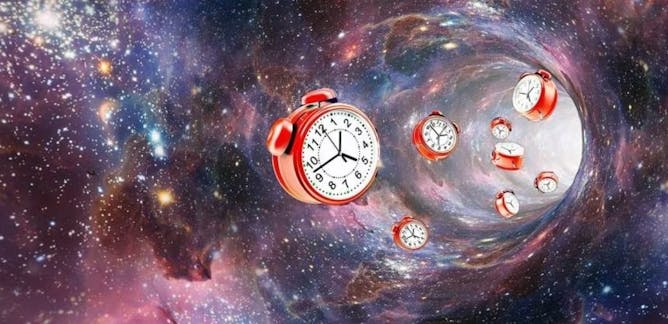
Is time travel even possible? An astrophysicist explains the science behind the science fiction
Adi Foord , University of Maryland, Baltimore County


Are black holes time machines? Yes, but there’s a catch
Sam Baron , Australian Catholic University

What are wormholes? An astrophysicist explains these shortcuts through space-time
Dejan Stojkovic , University at Buffalo

Curious Kids: is it possible to see what is happening in distant solar systems now?
Jacco van Loon , Keele University

Can we time travel? A theoretical physicist provides some answers
Peter Watson , Carleton University

Curious Kids: what would happen if someone moved at twice the speed of light?
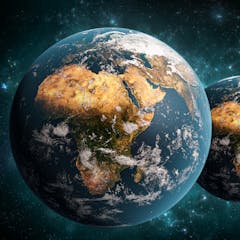
Time travel could be possible, but only with parallel timelines
Barak Shoshany , Brock University

Why does gravity pull us down and not up?
Mario Borunda , Oklahoma State University

New warp drive research dashes faster than light travel dreams – but reveals stranger possibilities
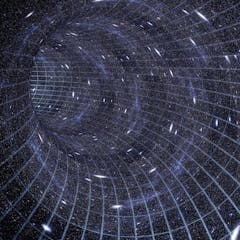
Curious Kids: is time travel possible for humans?
Lucy Strang , The University of Melbourne and Jacqueline Bondell , Swinburne University of Technology

Rotating black holes may serve as gentle portals for hyperspace travel
Gaurav Khanna , UMass Dartmouth
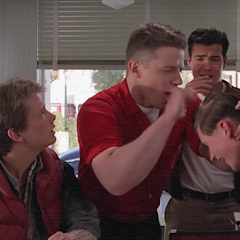
The great movie scenes: Back to the Future
Bruce Isaacs , University of Sydney
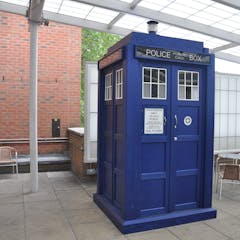
Time travel is possible – but only if you have an object with infinite mass
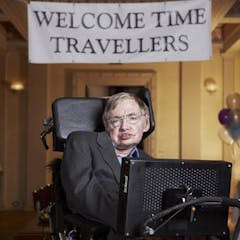
Stephen Hawking’s final book suggests time travel may one day be possible – here’s what to make of it
Peter Millington , University of Nottingham
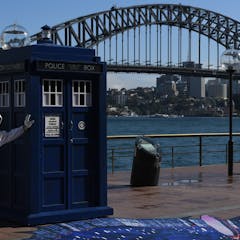
Like a TARDIS in your head, memory helps you travel through time
Alice Mason , The University of Western Australia
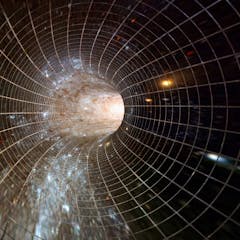
Time travel: a conversation between a scientist and a literature professor
Richard Bower , Durham University and Simon John James , Durham University

Star Trek’s version of time travel is more realistic than most sci fi
Lloyd Strickland , Manchester Metropolitan University

Anthill 1: About time
Annabel Bligh , The Conversation and Gemma Ware , The Conversation
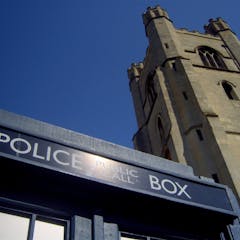
How to build a time machine
Steve Humble , Newcastle University
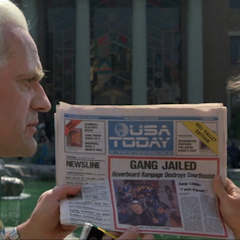
It’s Back to the Future Day today – so what are the next future predictions?
Michael Cowling , CQUniversity Australia ; Hamza Bendemra , Australian National University ; Justin Zobel , The University of Melbourne ; Philip Branch , Swinburne University of Technology ; Robert Merkel , Monash University ; Thas Ampalavanapillai Nirmalathas , The University of Melbourne , and Toby Walsh , Data61
Related Topics
- Albert Einstein
- Astrophysics
- Curious Kids
- Curious Kids US
- General Relativity
- Space travel
- Stephen Hawking
Top contributors
Associate Professor, Philosophy of Science, The University of Melbourne
Senior Lecturer in Philosophy, The University of Edinburgh
Professor of Physics, University of Rhode Island
Professor, University of Sydney
Honorary Research Associate, Centre for Time
Associate Professor in Telecommunications Engineering, Swinburne University of Technology
Emeritus Fellow, Trinity College, University of Cambridge
Former Academic Research Fellow, Khalifa University
Associate Professor, Film Studies, University of Sydney
Associate Professor – Information & Communication Technology (ICT), CQUniversity Australia
Lecturer in Software Engineering, Monash University
Professor in Physics, Durham University
Pro Vice-Chancellor, Graduate & International Research, The University of Melbourne
Professor of Philosophy and Intellectual History, Manchester Metropolitan University
Professor of Electrical and Electronic Engineering and Deputy Dean Research at Faculty of Engineering and Information Technology, The University of Melbourne
- X (Twitter)
- Unfollow topic Follow topic
Watch CBS News
New airline rules will make it easier to get refunds for canceled flights. Here's what to know.
By Megan Cerullo
Edited By Aimee Picchi
Updated on: April 25, 2024 / 12:56 PM EDT / CBS News
New consumer protection rules will soon entitle airline passengers to automatic refunds when flights are canceled or significantly delayed, while also requiring airlines to reveal junk fees upfront.
In total, the new rules could save travelers $500 million annually, Department of Transportation Secretary Pete Buttigieg said Wednesday, describing the regulations as "the biggest expansion of passenger rights in the department's history."
They take aim at some of the most common complaints against airlines, such as delays and difficulties getting refunds. Airlines will also have to disclose all possible fees, such as added costs for seat selection, when advertising a fare.
The regulations are likely to effect in October, officials said. Here's what to know about the new rules and what they mean for you.
You'll get an automatic refund for delayed or canceled flights
The first rule mandates that airlines promptly refund customers when flights are meaningfully disrupted or delayed. Airlines will have to refund customers the full ticket prices, including airline-imposed fees, as well as government taxes and fees.
In theory, passengers are already entitled to such refunds, but in practice airlines don't always provide them, Buttigieg noted. He said the new rule benefits infrequent fliers in particular, who may be less familiar with their rights.
This rule will save customers the hassle of dealing with a chatbot or completing a cumbersome claims process to receive refunds they're entitled to anyway when flights don't take off as scheduled.
Airlines often offer customers compensation in the form of vouchers or miles with values that are less than the flight's original cost. And passengers often must engage with customer service agents or chatbots to secure refunds, which can lead them to give up on the process altogether, according to Buttigieg.
How long of a delay will qualify for a refund?
The new rule defines what constitutes a "significantly changed" flight: a delay of at least three hours for a domestic flight, and at least six hours for an international flight. That was previously left to the discretion of the airline.
The rule says passengers will get automatic refunds in those cases as long as they don't accept alternative transportation or travel credits offered by the airline.
Passengers will also be entitled to refunds for other significant flight changes, according to the Department of Transportation.
These changes include flights whose departure or arrival airports change, that add connections or downgrade passengers to a different level of service. If a flight requires a passenger with a disability to make a connection at an airport or on a flight that is less accommodating, that also qualifies for a refund.
How long will it take to get a refund?
Airlines will have seven days to automatically refund passengers who purchased their tickets with a credit card, and 20 calendar days for other payment methods, the Transportation Department said.
"No more defaulting to vouchers or credits when consumers may not even realize they're entitled to cash," Buttigieg said.
Can I get a refund for delayed bags?
Yes, checked bag delays are also covered.
When bags aren't delivered within 12 hours of a domestic flight's arrival at its gate, passengers will get a refund for their checked bag fee. On international flights, bags that don't arrive within 15 to 30 hours, depending on a flight's length, are covered by the rule.
What other refunds will be available?
Airlines must also refund the costs of services customers paid for but then didn't receive on the flight, such as wifi, seat selection or in-flight entertainment, the Transportation Department said.
For instance, if passengers buy wifi access but it doesn't work properly, they are entitled to a refund for the service.
What is happening with surprise fees?
Transportation officials also announced a second rule on Wednesday that targets "junk" or surprise fees, which are charges that aren't typically disclosed to a consumer ahead of purchase.
Under the rule, airlines must disclose all fees the first time that airfare is advertised on an airline's site. Hyperlinks don't count, according to the agency.
The rule is designed to protect consumers against confusion caused by "drip pricing" by requiring airlines to disclose how much these additional fees will cost up front. That includes amounts airlines charge consumers to check bags, carry on bags, select seats, and change or cancel flights.
The rule is designed to help make it easier for passengers to estimate the full cost of flying so they can make an informed purchase.
Are seats guaranteed if I buy a ticket?
Under the second rule, airlines will also have to make clear to customers that if they buy a ticket, they're guaranteed a seat — even if they don't fork over additional money to choose where on the plane that seat is located.
How will I know I'm seeing the actual flight price?
The second rule also bars airlines from advertising artificially low prices that don't factor in mandatory fees.
The Transportation Department said this will end "discount bait-and-switch tactics" that dangle deceptive discounts to convince travelers to buy tickets.
What do airlines say about the new rules?
Airlines for America, a trade group for large U.S. carriers, noted that refund complaints to the Transportation Department have fallen sharply since mid-2020.
A spokesperson for the group said airlines "offer a range of options — including fully refundable fares — to increase accessibility to air travel and to help customers make ticket selections that best fit their needs."
The group said the 11 largest U.S. airlines issued $43 billion in customer refunds from 2020 through 2023.
While Buttigieg said airlines aren't "enthusiastic" about being held to a higher standard, he believes the new rules will build passenger confidence in companies and ultimately benefit the industry as a whole.
Buttigieg also said he hopes the new rules will push carriers to improve the consumer experience. For example, if an airline knows it will automatically owe customers refunds for canceled flights, it might invest more in precise scheduling, and ultimately reduce the number of cancellations overall.
—With reporting by the Associated Press.
Megan Cerullo is a New York-based reporter for CBS MoneyWatch covering small business, workplace, health care, consumer spending and personal finance topics. She regularly appears on CBS News 24/7 to discuss her reporting.
More from CBS News

Clear, a new TSA PreCheck enrollment provider, is now at these airports

Walmart is launching an upscale store brand. Here what it's selling.

Can you get a reverse mortgage if you're younger than 62?

New NASA images show iconic Horsehead Nebula in unprecedented detail
Advertisement
Supported by
Even as He Faces Prison Time, Binance’s Founder Plans a Comeback
Since pleading guilty to violating money-laundering rules, Changpeng Zhao, who ran the giant crypto exchange Binance, has networked across the United States to set up his next act.
- Share full article

By David Yaffe-Bellany and Cade Metz
He enjoyed a home-cooked dinner in Montana with a former U.S. senator. He visited Telluride, Colo., and Moab, Utah, a vacation spot known for its national parks. And he chatted about start-ups with Sam Altman, the chief executive of OpenAI.
After pleading guilty to a money-laundering violation in November, Changpeng Zhao, the founder of the cryptocurrency exchange Binance, did not sit still. A federal judge denied his request to return home to Dubai, but Mr. Zhao, 47, was free to roam the United States. So he spent the past five months traveling the country, networking with other entrepreneurs and laying the groundwork for his next act.
When he pleaded guilty, Mr. Zhao, once the most powerful figure in the global crypto industry, resigned as Binance’s chief executive and agreed to pay a $50 million fine. On Tuesday, a federal judge in Seattle sentenced him to four months in prison ; prosecutors had sought a three-year prison term, while defense lawyers had asked for probation and no time behind bars.
But Mr. Zhao, who goes by the initials CZ, is already looking to the future. He has a $33 billion fortune, according to Forbes , and he announced last month that he was starting a new web platform to promote online education.
Mr. Zhao has also expressed interest in investing in artificial intelligence and biotechnology, and has corresponded with other executives. Late last year, he and Mr. Altman exchanged text messages, two people familiar with the matter said, and discussed the challenges of expanding a start-up worldwide.
Many powerful crypto executives have faced federal lawsuits and criminal charges since the multitrillion-dollar industry imploded in 2022. Some have gone to prison , while others have enjoyed the high life before being arrested . Mr. Zhao’s fate is likely to be kinder than most.
His frenetic activity since November contrasts with the consequences faced by Sam Bankman-Fried , the founder of the collapsed crypto exchange FTX. Once Mr. Zhao’s greatest rival, Mr. Bankman-Fried was largely ostracized after FTX imploded in 2022 and prosecutors charged him with stealing $8 billion in customer funds. A jury found him guilty of fraud last year, and he was sentenced in March to 25 years in prison.
Mr. Zhao, who pleaded guilty three weeks after Mr. Bankman-Fried was convicted at trial, still enjoys widespread support in the crypto industry. Dozens of current and former Binance employees have submitted letters to Judge Richard A. Jones, the federal judge overseeing Mr. Zhao’s case, asking him to impose a lenient sentence. And many crypto entrepreneurs, investors and dignitaries have continued supporting Mr. Zhao, court records show.
A short prison stint “is a small price to pay to be a billionaire for life,” said John Reed Stark, a former Securities and Exchange Commission official and a critic of the crypto industry. “The industry just does not care about the extraordinary crypto crime wave ushered in by people like CZ.”
Representatives for Mr. Zhao and OpenAI declined to comment.
For much of Binance’s existence, Mr. Zhao was dogged by accusations that he had broken the law to build a crypto empire. Binance was the world’s largest crypto exchange, processing as much as two-thirds of all transactions. And Mr. Zhao became a crypto celebrity, with nearly nine million followers on X. His posts helped set off a chain of events that led to FTX’s demise in 2022.
Last year, Binance faced its own reckoning. The company agreed to pay $4.3 billion to the U.S. government to settle charges that it allowed criminal activity to flourish on the exchange.
U.S. officials said Binance violated economic sanctions, allowing access to its platform to people in countries like Cuba, Syria and Iran. Mr. Zhao failed to set up proper anti-money-laundering controls, prosecutors said, and let customers sign up for accounts without providing the basic personal details that financial services firms usually require.
“Zhao violated U.S. law on an unprecedented scale,” prosecutors wrote in a court filing on Wednesday. “Zhao’s sentence should reflect the gravity of his crimes.”
Mr. Zhao started talking about his next act the moment the charge against him was announced. In a post on X the day of his plea hearing in November, for which he appeared in person in federal court in Seattle, he said he was interested in investing in areas like crypto, biotechnology and A.I.
“I may be open to being a coach/mentor to a small number of upcoming entrepreneurs,” he wrote. “If for nothing else, I can at least tell them what not to do.”
In a filing last week, prosecutors said Mr. Zhao had traveled throughout the United States, visiting New York, Los Angeles, Telluride and Moab. Mr. Zhao, who grew up partly in Canada, has spent some of his free time skiing and snowboarding, a person who knows him said.
Mr. Zhao met Mr. Altman in person about a year ago, a person with knowledge of the matter said. They were in contact again after a leadership battle at OpenAI in late November, two people familiar with the exchange said. The next month, over hot pot in Los Angeles, Mr. Zhao told Ronghui Gu, a computer science professor at Columbia University, that he had communicated with Mr. Altman.
“He talked to Sam, and they both believe that A.I. is going to help a lot in actualizing the development of technology and human knowledge,” Mr. Gu, who founded a start-up that Binance helped fund, said in an interview.
At the same meal, Mr. Zhao mentioned that he was “looking for opportunities” to invest in the large data centers that power A.I. applications, Mr. Gu said.
(The New York Times has sued OpenAI and its partner, Microsoft, claiming copyright infringement of news content related to A.I. systems.)
In a letter filed in court last week, Mr. Zhao said he had also spoken with “a number of biotech start-ups” in recent months and planned to make disease prevention a focus in the next chapter of his life.
“I’d like to help fund small research labs with the aim of curing diseases once and for all, as well as providing medical access to billions in the world using blockchain technologies,” he wrote.
In March, Mr. Zhao announced on X that he was starting a project called Giggle Academy, a free online learning platform for children. A seven-page “ concept paper ” posted on Giggle Academy’s website said the platform would involve A.I. and automation, as well as nonfungible tokens, the unique digital collectibles known as NFTs.
Mr. Zhao wrote on X that Giggle Academy would have “no revenue” and that he was recruiting a small team to work directly with him.
On his travels, Mr. Zhao has also caught up with influential acquaintances. A couple of months ago, he had dinner at the Montana home of Max Baucus, a former U.S. senator and ambassador to China. In a letter filed in court last week, Mr. Baucus, who worked for Binance as an adviser, said he and Mr. Zhao had discussed the criminal case.
“He didn’t make any excuses except to note he didn’t hurt anyone,” wrote Mr. Baucus, a Democrat. “He didn’t use others funds for his own account distinguishing him from Sam Bankman-Fried, who did just that.”
At the dinner with Mr. Gu in December, Mr. Zhao was joined by his son, a freshman at Pepperdine University. The dinner was mostly casual, Mr. Gu wrote in a letter to the court last week. He and Mr. Zhao discussed their shared interest in crypto, as well as “insights on being a good C.E.O.”
Then Mr. Zhao’s son asked his father whether he was really guilty. “The sudden silence that followed was palpable,” Mr. Gu wrote. “He acknowledged his mistakes and his guilt, emphasizing that making mistakes is not something to be ashamed of.”
Mr. Zhao soon lightened the mood, the letter said, cracking a joke about Mr. Gu’s “continued willingness to dine with them.”
Kitty Bennett contributed research.
David Yaffe-Bellany writes about the crypto industry from San Francisco. He can be reached at [email protected]. More about David Yaffe-Bellany
Cade Metz writes about artificial intelligence, driverless cars, robotics, virtual reality and other emerging areas of technology. More about Cade Metz
Inside the World of Cryptocurrencies
Tigran Gambaryan, an American compliance official for the giant cryptocurrency exchange Binance, flew to Nigeria in February for a planned two-day business trip. Here’s how he ended up in a Nigerian prison .
Two years after the cryptocurrency market crashed, there are signs that crypto is booming again in the Philippines, long a center of crypto activity .
Pushed by a nonprofit with ties to the Trump administration, Arkansas became the first state to shield noisy cryptocurrency operators from unhappy neighbors. A furious backlash has some lawmakers considering a statewide ban .
Ben Armstrong, better known as BitBoy, was once the most popular cryptocurrency YouTuber in the world. Then his empire collapsed .
Federal judges are weighing whether digital currencies should be subject to the same rules as stocks and bonds. The outcome could shape crypto’s future in the United States .
New investment funds that hold Bitcoin have begun trading , and it might be tempting to invest in them. Should you ?
Parking and Transportation
May 3-6 Parking Notice: To provide clean and safe parking facilities, Hospital Parking Ramp 1 will be closed for maintenance.
Vehicles will not be permitted to enter the parking ramp beginning at 4 p.m. on Friday, May 3, and vehicles need to be removed by 6 p.m. Friday. The parking ramp will re-open at 3 a.m. on Monday, May 6. See complete details.
Fleet Services Newsletter, April 2024
New wright express fuel credit cards are here.
New WEX cards have arrived and we have already begun swapping them out. Through May both the old and new cards are active, so in order to get the new card you must bring your old card to our office. If your drivers are based outside of Iowa City, please contact our office to arrange exchanging those cards. The old cards will expire at the end of May so beginning June 1 st a card can be picked up without turning in the old card.
Don’t forget that If you have a fuel card for a lawn mower, generator, boat motor, pump or other piece of equipment, those cards are expiring too!! Please bring the old card to our office and we’ll exchange it.
The Diesel Blend is a Changin’
As the weather warms up our blend of diesel fuel will be changing. The most recent load we received is B-10 (containing 10% Biodiesel) and the next load will be B-20 (20% Biodiesel). We will have this more sustainable higher bio blend through the warmer months before we transition back for winter.
Lee County Speed Cameras
Some of our vehicles traveling for Spring Break received speed camera tickets from Lee County Iowa, speed cameras that quite frankly were not on our radar (pun intended). There are 6 total cameras along Hwy 218 / IA 27 near Donnelson, Charleston, and Argyle Iowa. Check out their website with a map of the camera locations and a breakdown of the fee schedule. Per policy, the driver of the vehicle is responsible for paying all violations.
Take the Distracted Driving Awareness Pledge!
April is Distracted Driving Awareness month. What is distracted driving? It can be anything that takes your attention away from the road, like talking on the phone, texting, eating, or even just messing with the radio. Similarly to the impairment of drunk driving, distracted driving can slow your reaction time, make it difficult to focus on the road, and impair your ability to drive safely. In 2022, 3,308 lives were lost as a result of distracted driving. If you need to talk on the phone, pull over to a safe location. If you need to change the radio, wait until you are stopped at a red light. Just remember, you cannot drive safely unless the task of driving has your full attention. Check out the link to NHTSA’s page with more information and where you can take the pledge to not drive distracted. If you have children or a partner ask them to take the pledge too!
Honest Mikes Used Cars
We have a nice variety of vehicles live for auction on GovDeals right now. We have a 2016 White Chevy Silverado 2500 with 4wd, a double cab, and only 37k miles. Also live right now is a 2019 silver Chevy Malibu with 67k miles and a 2014 silver Nissan Frontier 4x2 with super low mileage, just less than 11k. If a minivan is what you fancy we have a couple of those too. Currently listed is a Silver 2018 Grand Caravan with 58k miles and a white 2019 Grand Caravan with 45K miles. Take a look at our auction page on GovDeals .
Parking a Personal Vehicle During a Rental Reservation
When you pick up one of our rental vehicles, we always ask you to, “…park on the other side of the utility/telephone pole” in the middle of our lot. That is at the far east side closer to Madison Street. Our lot has been extra full lately, so we need the space up front for folks to return vehicles. There is also less traffic on that side of the lot and less chance someone will bump into your vehicle.
Fleet Factoid
GreenerCars.org has released their rankings for the “greenest” cars of the year. Surprisingly the winner was not a pure electric vehicle, it was a plug-in hybrid Prius Prime. The top 12 consists of seven battery EVs, two plug-in hybrids like the Prius, and two gas-electric hybrids. Unlike other evaluations that only look at fuel-efficiency, GreenerCars scores vehicles on their entire environmental impact. GreenerCars looks at the greenhouse gas and pollutant emissions from the production of the vehicle, its use, and the disposal of the vehicle. The takeaway is that simply running on electricity is not enough to guarantee that a car is “green”, factors such as weight, battery size and overall efficiency also matter. Check out the full rankings .
I quit a comfortable tech job to launch a startup. Moving back in with my mom was humbling, but now I make $400,000 and travel all the time.
- Gene Caballero left his stable job at Dell to cofound GreenPal, an on-demand lawn care service.
- He had to make financial sacrifices in the beginning, but now he earns more and travels often.
- He's happy as an entrepreneur and will never return to 9-5 life despite the challenges.

This as-told-to essay is based on a conversation with Gene Caballero, a 44-year-old cofounder of GreenPal, based in Nashville. It's been edited for length and clarity.
I'm a cofounder of GreenPal, a platform that connects homeowners with lawn care professionals.
After purchasing my first home, finding reliable lawn care for myself and my mom was a daunting task. Working in tech on the West Coast and watching companies like Uber, Lyft, and Airbnb get started opened my eyes to one of my cofounders Bryan Clayton's initial idea of on-demand lawn care.
Before working full-time at GreenPal, I spent nine years at Dell , where I first held a sales role. Five years in, I transitioned into a management role, where I stayed until 2017. I learned invaluable lessons in leadership, strategic planning, and team management, all of which have been crucial in steering GreenPal toward success.
I left my stable job at Dell to find a more meaningful career
I had a six-figure salary and was comfortable at Dell, but launching GreenPal was fueled by a quest for greater purpose. I was driven by the urge to solve a common problem. This venture into entrepreneurship was not just a career change but a commitment to innovating how lawn care services are accessed.
Financing GreenPal's inception demanded significant personal sacrifices. Because of my belief in GreenPal, I sold my house and cashed out my 401(k) . To make this work, I moved home with my mom for a year, which was humbling, but I knew it was the right choice. I then got a small apartment with Bryan.
Related stories
A key part of our early strategy was going door-to-door to gather feedback from homeowners. This direct engagement was crucial in validating the demand for a service like GreenPal and refining our concept based on real user insights. It gave me the confidence to go all in.
We're now making over $40 million in revenue
Since our founding, we've hired 20 employees. The financial health of the company affords me personal freedoms that were once unimaginable — especially in the corporate world.
My compensation of $400,000 annually supports my lifestyle of travel and exploration. In 2023, I visited 15 countries, and I've already planned five international trips, including summiting Kilimanjaro in September, for this year.
I work every day, but I've streamlined my responsibilities so I never exceed 20 hours a week. Every morning, I look at the number of transactions and revenue we booked the previous day. I then tackle emails, prioritizing our customer care app to promptly address all inquiries and issues. I'm usually done working by noon, if not earlier.
My entrepreneurial journey was both exhilarating and challenging
One of our most impactful mistakes was hiring an external firm to develop our website and apps. Entrusting this critical component to an outside company for a six-figure fee, we expected a seamless launch and a robust platform. The firm failed to deliver a product that met our specifications and went out of business shortly after. This left us without a functional website and with no recourse to recover our investment.
The setback delayed our market entry and forced us to reconsider our strategy. This experience taught us a crucial lesson about the importance of having technical expertise within our founding team. My other cofounder, Zach Hendrix, went to Nashville Software School and learned how to build the current website and apps we use today.
I absolutely do not miss my 9-5 at all
One piece of advice I'd share with other entrepreneurs is to brace yourself for a ride that can be lonely and seemingly without reward for a long stretch. Success in entrepreneurship often comes after enduring periods of uncertainty and solitude. Stay resilient and keep pushing forward, even when the immediate outcomes aren't visible.
I consider myself an entrepreneur, but I will never start another company. If you do it right once, you don't need to do it again.
Watch: Marketing leaders from Amazon, LinkedIn, Lego Group and more tell Insider what pandemic-fueled business changes are likely to stick around
- Main content
- Credit cards
- View all credit cards
- Banking guide
- Loans guide
- Insurance guide
- Personal finance
- View all personal finance
- Small business
- Small business guide
- View all taxes
You’re our first priority. Every time.
We believe everyone should be able to make financial decisions with confidence. And while our site doesn’t feature every company or financial product available on the market, we’re proud that the guidance we offer, the information we provide and the tools we create are objective, independent, straightforward — and free.
So how do we make money? Our partners compensate us. This may influence which products we review and write about (and where those products appear on the site), but it in no way affects our recommendations or advice, which are grounded in thousands of hours of research. Our partners cannot pay us to guarantee favorable reviews of their products or services. Here is a list of our partners .
Where Americans Are Traveling in 2024: By the Numbers

Many or all of the products featured here are from our partners who compensate us. This influences which products we write about and where and how the product appears on a page. However, this does not influence our evaluations. Our opinions are our own. Here is a list of our partners and here's how we make money .
Americans are traveling abroad in droves.
The number of U.S. citizens flying to international destinations reached nearly 6.5 million passengers in March, according to the International Trade Administration. That’s the highest March total in over five years and shows that the post-pandemic “revenge travel” trend is the new normal.
It wasn’t just March, which usually sees a spike in international departures for spring break. In every month of 2024 so far, more Americans left the country than last year and 2019. These trends point to a blockbuster summer for overseas travel.
Nearly half of Americans (45%) plan to travel by air and/or stay in a hotel this summer and expect to spend $3,594 on average, on these expenses, according to a survey of 2,000 U.S. adults, conducted online by The Harris Poll and commissioned by NerdWallet.
That's despite rising travel prices that have caused some hesitancy among would-be travelers. About 22% of those choosing not to travel this summer cite inflation making travel too expensive as a reason for staying home, according to the poll.
So where are traveling Americans going? And what does it mean for those looking to avoid crowds of tourists and higher travel prices?
New travel patterns
Nearly every region in the world saw an increase in U.S. visitors in March 2024 compared with March 2023, according to International Trade Administration data. Only the Middle East saw a decline of 9%. Yet not every region saw the same year-over-year bump. U.S. visitors to Asia saw a 33% jump, while Oceania and Central America each saw a 30% increase.
Comparing 2024 with 2023 only tells part of the story, however. The new patterns really emerge when comparing international travel trends to 2019. For example, Central America received 50% more U.S. visitors in March 2024 compared with March 2019. Nearly 1.5 million Americans visited Mexico, up 39% compared with before the pandemic. That’s almost as many visitors as the entire continent of Europe, which has seen a more modest 10% increase since 2019.
Only Canada and Oceania saw fewer visitors in March 2024 than in 2019, suggesting that interest in these locations has not rebounded. Indeed, the trends indicate a kind of tourism inertia from COVID-19 pandemic-era lockdowns: Those destinations that were more open to U.S. visitors during the pandemic, such as Mexico, have remained popular, while those that were closed, such as Australia, have fallen off travelers’ radars.
Price pressures
How these trends play out throughout the rest of the year will depend on a host of factors. Yet, none will likely prove more important than affordability. After months of steadiness, the cost of travel, including airfare, hotels and rental cars, has begun to sneak up again.
About 45% of U.S. travelers say cost is their main consideration when planning their summer vacation, according to a survey of 2,000 Americans by the travel booking platform Skyscanner.
That’s likely to weigh further on U.S. travelers’ appetite for visiting expensive destinations such as Europe, while encouraging travel to budget-friendly countries. It could also depress overall international travel as well, yet so far, Americans seem to be traveling more.
For those looking to avoid crowds while maintaining a budget, Skyscanner travel trends expert Laura Lindsay offered a recommendation many of us might need help finding on a map.
“Albania has been on the radar of travelers looking for something different,” Lindsay said. "Most people have yet to discover it, but flights and tourism infrastructure are in place, and there are fewer crowds in comparison to trending European destinations like Italy, Greece, or Portugal.”
On the flip side, American travelers looking to avoid crowds of compatriots would do well to avoid Japan, which has seen a staggering 50% increase in U.S. tourists between March 2019 and 2024.
How to maximize your rewards
You want a travel credit card that prioritizes what’s important to you. Here are our picks for the best travel credit cards of 2024 , including those best for:
Flexibility, point transfers and a large bonus: Chase Sapphire Preferred® Card
No annual fee: Bank of America® Travel Rewards credit card
Flat-rate travel rewards: Capital One Venture Rewards Credit Card
Bonus travel rewards and high-end perks: Chase Sapphire Reserve®
Luxury perks: The Platinum Card® from American Express
Business travelers: Ink Business Preferred® Credit Card
On a similar note...


The Napkin Project (Love Stories Edition)
Our prompt to five extraordinary writers: “Write a love story.” The results—meet-cutes, time-traveling couples, blind dates gone wrong—remind us why stories of the heart are the backbone of fiction.
The oldest stories in the world are love stories. Boy meets girl; girl shares her campfire; they live happily ever after, two cavepeople against the cruel world. In the millennia since, the form has only improved and multiplied—now our bookshelves are packed with tales of joy and heartbreak, love and loss, breaking up and making up.
So when we asked five extraordinary writers to submit works of short fiction contained on cocktail napkins, we gave them this prompt: “Write a love story.” The results remind us why love stories are the backbone of modern fiction. The proof is spelled out in the writers’ own handwriting.
In one story, a coffee shop meet-cute links two shy young people; in another, time-traveling lovers enjoy not one but several meet-cutes across the ancient world, from Babylon to Rome to Constantinople. Of course, love isn’t all sunshine and roses; elsewhere in this collection, a blind date goes comically sideways and a lovelorn man regrets the limits of what he can give. Finally, one work of fiction celebrates a woman’s greatest love affair: one with her own pleasure.
So go ahead—join us at the bar. Enjoy these tales of love, longing, and woe, and maybe scribble down your own. After all, everyone has a love story to tell. — Adrienne Westenfeld, Books and Fiction Editor
Andrew Sean Greer

Jasmine Guillory

Gabino Iglesias

Curtis Sittenfeld

Jess Walter

@media(max-width: 73.75rem){.css-1ktbcds:before{margin-right:0.4375rem;color:#FF3A30;content:'_';display:inline-block;}}@media(min-width: 64rem){.css-1ktbcds:before{margin-right:0.5625rem;color:#FF3A30;content:'_';display:inline-block;}} Books

The Napkin Project: Andrew Sean Greer

The Napkin Project: Curtis Sittenfeld

The Napkin Project: Gabino Iglesias

The Napkin Project: Jess Walter

The Napkin Project: Jasmine Guillory

Writing Through the War in Ukraine

Inside the Literary Travel Boom

The Best Horror Books of 2024 (So Far)

Why ‘Carrie’ Is Still Scary as Shit

Holly Gramazio Can Solve Your Dating Burnout

Hanif Abdurraqib Knows What Makes Basketball Great

IMAGES
VIDEO
COMMENTS
In Summary: Yes, time travel is indeed a real thing. But it's not quite what you've probably seen in the movies. Under certain conditions, it is possible to experience time passing at a different rate than 1 second per second. And there are important reasons why we need to understand this real-world form of time travel.
Time traveling to the near future is easy: you're doing it right now at a rate of one second per second, and physicists say that rate can change. According to Einstein's special theory of ...
Time Travel Theoretically Possible Without Leading To Paradoxes, Researchers Say In a peer-reviewed journal article, University of Queensland physicists say time is essentially self-healing ...
An observer traveling at high velocity will experience time at a slower rate than an observer who isn't speeding through space. While we don't accelerate humans to near-light-speed, we do send ...
The simplest answer is that time travel cannot be possible because if it was, we would already be doing it. One can argue that it is forbidden by the laws of physics, like the second law of ...
Albert Einstein's theory of relativity says time and motion are relative to each other, and nothing can go faster than the speed of light, which is 186,000 miles per second. Time travel happens ...
Scientists are trying to figure out if time travel is even theoretically possible. If it is, it looks like it would take a whole lot more knowledge and resources than humans have now to do it.
Time Travel. First published Thu Nov 14, 2013; substantive revision Fri Mar 22, 2024. There is an extensive literature on time travel in both philosophy and physics. Part of the great interest of the topic stems from the fact that reasons have been given both for thinking that time travel is physically possible—and for thinking that it is ...
Time Travel and Modern Physics. First published Thu Feb 17, 2000; substantive revision Mon Mar 6, 2023. Time travel has been a staple of science fiction. With the advent of general relativity it has been entertained by serious physicists. But, especially in the philosophy literature, there have been arguments that time travel is inherently ...
One attempt at resolving time travel paradoxes is theoretical physicist Igor Dmitriyevich Novikov's self-consistency conjecture, which essentially states that you can travel to the past, but you cannot change it. According to Novikov, if I tried to destroy my time machine five minutes in the past, I would find that it is impossible to do so.
Time travel exerts an irresistible pull on our scientific and storytelling imagination. Since H.G. Wells imagined that time was a fourth dimension —and Einstein confirmed it—the idea of time ...
Time travel and parallel timelines almost always go hand-in-hand in science fiction, but now we have proof that they must go hand-in-hand in real science as well. General relativity and quantum ...
Einstein found that the faster you move through space, the slower you move through time — you age more slowly, in other words. One of the key ideas in relativity is that nothing can travel ...
It's tricky. Scientific theories suggest it's possible to travel through time. But the reality isn't so clear. Time travel has fascinated scientists and writers for at least 125 years. The ...
Mathematics suggested that time travel is physically possible - and Kurt Gödel proved it. Mathematician Karl Sigmund explains how the polymath did it. By Karl Sigmund. 5 April 2024. Gödel ...
The source of time travel speculation lies in the fact that our best physical theories seem to contain no prohibitions on traveling backward through time. The feat should be possible based on ...
Dec 31, 2022, 9:13 AM PST. Doc Brown and Marty McFly in "Back to the Future." Universal Pictures. Time travel is possible based on the laws of physics, according to researchers. But time-travelers ...
Mallett was aged 10 when his father died suddenly, of a heart attack, an event that the scientist says changed the track of his life forever. "For me, the sun rose and set on him, he was just ...
Time Travel. Time travel is commonly defined with David Lewis' definition: An object time travels if and only if the difference between its departure and arrival times as measured in the surrounding world does not equal the duration of the journey undergone by the object. For example, Jane is a time traveler if she travels away from home in ...
An image of a chain link. It symobilizes a website link url. Copy Link When I was working remotely in 2021, my boyfriend and I packed up and traveled to 22 countries across Europe and Latin ...
Whether flying or driving, I have a maximum 3-hour travel time to enjoy most of my time at the destination. undefined. Exploring Athens, Greece after a red-eye flight
Articles on Time travel. Displaying 1 - 20 of 25 articles. If traveling into the past is possible, one way to do it might be sending people through tunnels in space.
Secretary Buttigieg unpacks new rules on airline fees and refunds 07:18. New consumer protection rules will soon entitle airline passengers to automatic refunds when flights are canceled or ...
In a filing last week, prosecutors said Mr. Zhao had traveled throughout the United States, visiting New York, Los Angeles, Telluride and Moab. Mr. Zhao, who grew up partly in Canada, has spent ...
Similarly to the impairment of drunk driving, distracted driving can slow your reaction time, make it difficult to focus on the road, and impair your ability to drive safely. In 2022, 3,308 lives were lost as a result of distracted driving. ... Some of our vehicles traveling for Spring Break received speed camera tickets from Lee County Iowa ...
Moving back in with my mom was humbling, but now I make $400,000 and travel all the time. As told to Perri Ormont Blumberg. 2024-04-29T09:05:01Z An curved arrow pointing right. Share. The ...
Comparing 2024 with 2023 only tells part of the story, however. The new patterns really emerge when comparing international travel trends to 2019.
All quotes are in local exchange time. Real-time last sale data for U.S. stock quotes reflect trades reported through Nasdaq only. Intraday data delayed at least 15 minutes or per exchange ...
The results—meet-cutes, time-traveling couples, blind dates gone wrong—remind us why stories of the heart are the backbone of fiction. By Adrienne Westenfeld Published: Apr 29, 2024.
In Japan, which is home to half of the world's companies that are at least 100 years old, a simple but powerful philosophy has contributed to business longevity: Sampo-yoshi. Sampo-yoshi means "good for the seller, good for the buyer, and good for society." Its origins trace to traveling traders from the Ohmi region — now known as Shiga Prefecture — who were active for centuries.